I was away at the end of April and the start of May so I missed some of the action but fortunately other PAM members kept me up to date and took lots of photos and videos for us all to enjoy. Overall, the weather in May was pretty good and a fair bit of flying was enjoyed but of course the mixture of warm sunshine interspersed with rain showers meant that the grass grew quickly. As I mentioned last month we’ve had to replace the old yellow mower and Gordon Bennett sourced a replacement and a second mower box to protect it from the elements. This was kindly delivered to the field by our always helpful farmer and put in place and painted by 1066 and Woody. The patch can now be cut much more easily and is in great condition, especially considering it was just a field a few months ago.
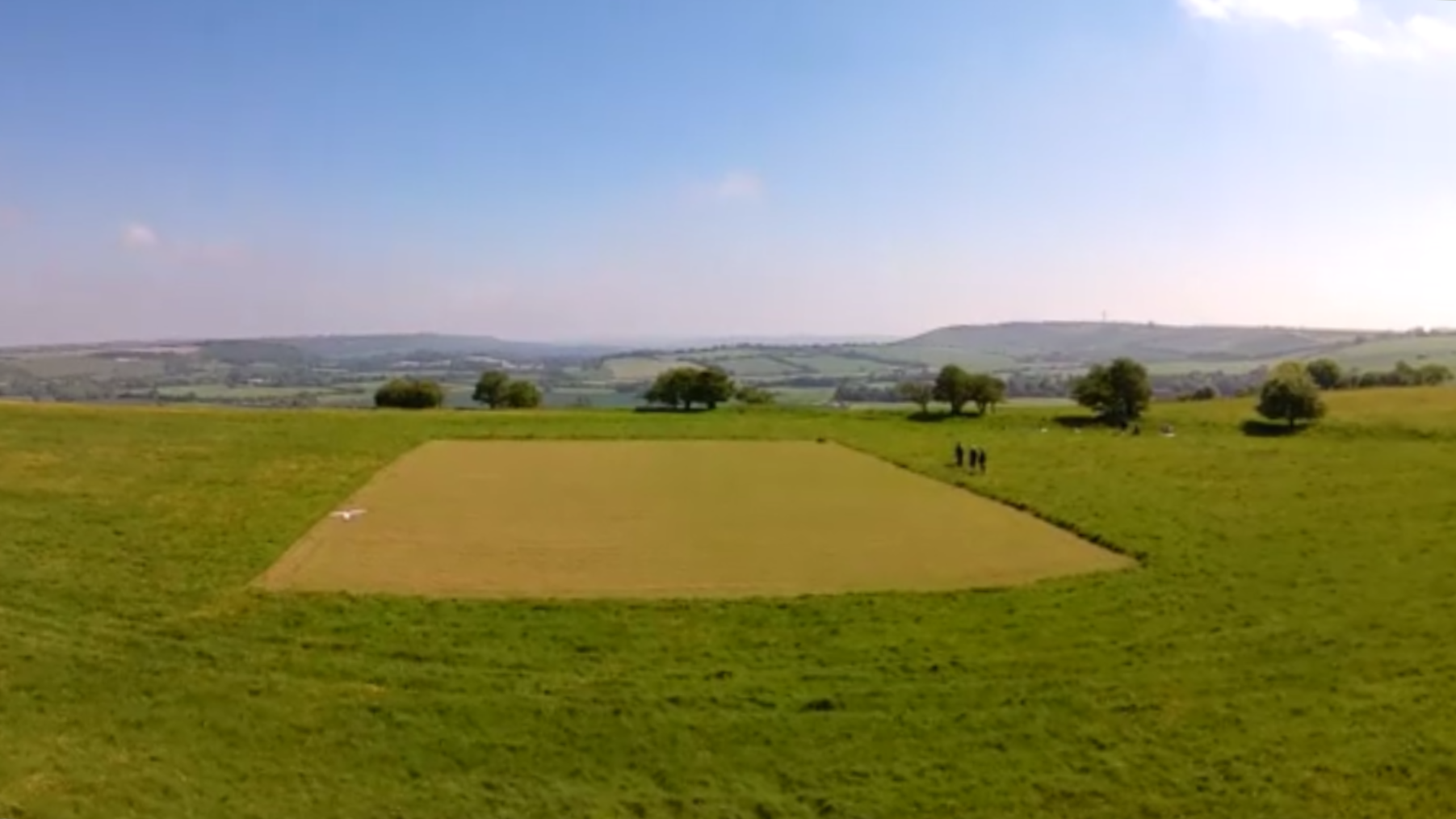
One day we spotted a deer in the field as we arrived. It quickly ran off as we approached but it was nice to see even if only briefly. I just had time to take this rather blurry picture: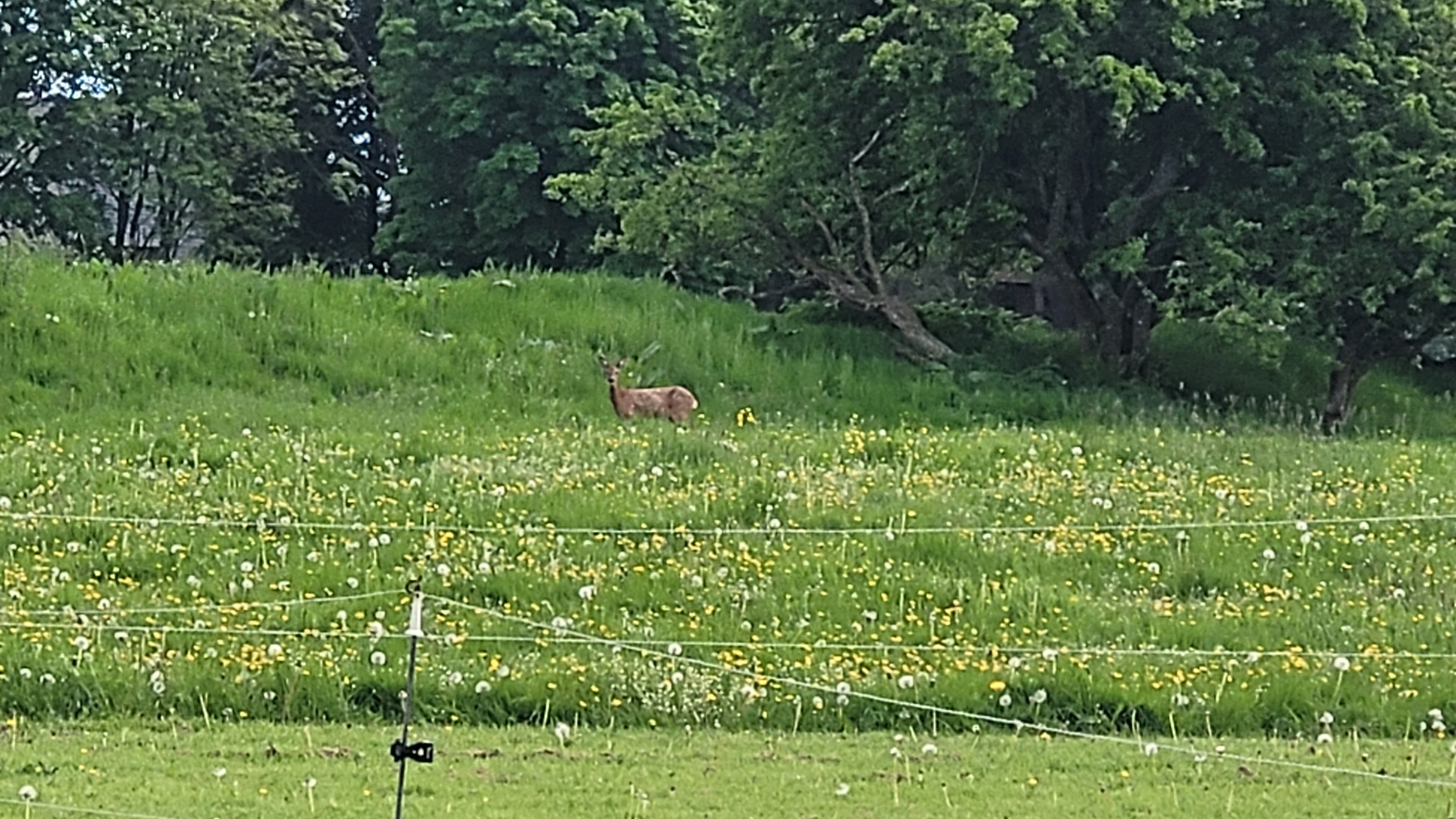
At the end of April Woody brought along a model that he’d built from a plan by Tomas Hellberg. Tomas has a great website with plans and information for various foamies that can be downloaded for free: rc.tomhe.net Woody’s is an F/A-18 Super Hornet which is designed to be built from 6mm Depron but Woody has used Hobbycraft foamboard.
 The Hornet has a wingspan of 735mm and a length of 1025mm and, like the other foamboard models, is supposed to be fitted with a centre mounted motor with the propellor running in a slot. We know that this arrangement can be noisy due to the propellor being close to the slot although enlarging the slot to increase the clearance, especially in front of the propellor, can reduce the noise significantly. Being concerned about the noise and not wanting to upset our new neighbours Woody decided to fit his Hornet with a 50mm FMS ducted fan unit which would definitely be a quieter option.
The Hornet has a wingspan of 735mm and a length of 1025mm and, like the other foamboard models, is supposed to be fitted with a centre mounted motor with the propellor running in a slot. We know that this arrangement can be noisy due to the propellor being close to the slot although enlarging the slot to increase the clearance, especially in front of the propellor, can reduce the noise significantly. Being concerned about the noise and not wanting to upset our new neighbours Woody decided to fit his Hornet with a 50mm FMS ducted fan unit which would definitely be a quieter option.
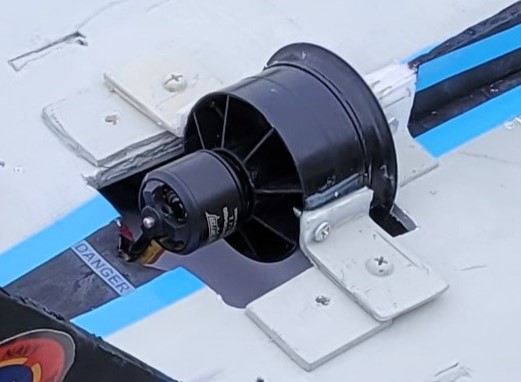 The designer’s model used tailerons only for control although he does mention that ailerons can be added as an option and Woody has done that. He’s linked each aileron to a taileron using one Tower Pro servo each side, a system I first saw on the HobbyKing SU-27 foamie. It seems a very odd set-up as when up elevator is applied the ailerons also go up rather than down but it worked very well on the SU-27. Woody has finished his Hornet in the colour scheme of the one flown by Captain Pete Mitchell (Maverick) in the movie Top Gun Maverick. So, does it make Woody fly like Tom Cruise? Er…no…well not yet anyway.
The designer’s model used tailerons only for control although he does mention that ailerons can be added as an option and Woody has done that. He’s linked each aileron to a taileron using one Tower Pro servo each side, a system I first saw on the HobbyKing SU-27 foamie. It seems a very odd set-up as when up elevator is applied the ailerons also go up rather than down but it worked very well on the SU-27. Woody has finished his Hornet in the colour scheme of the one flown by Captain Pete Mitchell (Maverick) in the movie Top Gun Maverick. So, does it make Woody fly like Tom Cruise? Er…no…well not yet anyway. 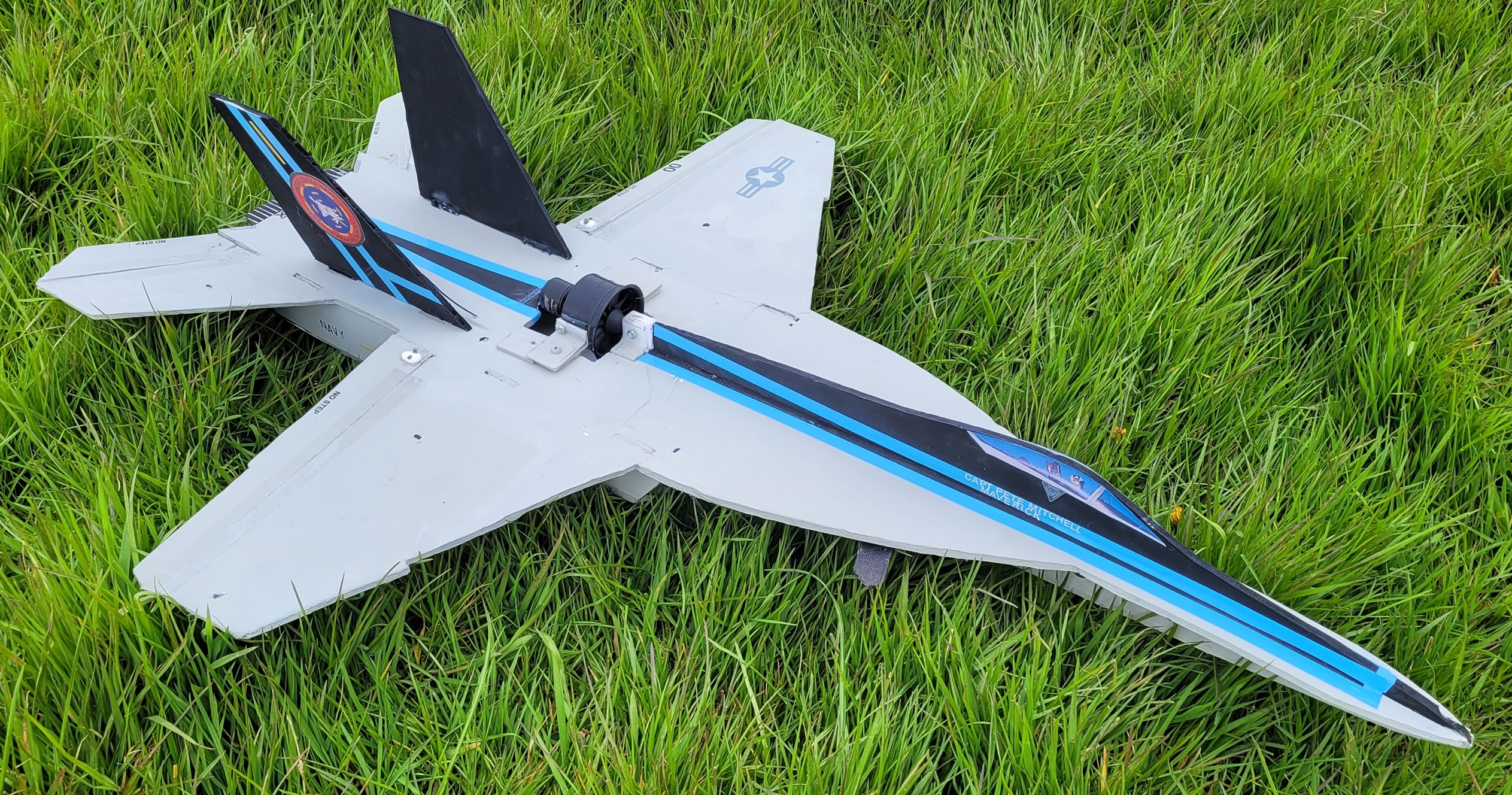 The initial test flights with the EDF unit showed that although the model sounded good there simply wasn’t enough power. So Woody reluctantly replaced the FMS unit with a Turnigy Aerodrive 2826/6 2200kv motor and a 6×4.5 prop. I had a few more test flights with it and made various changes which included moving the centre of gravity forward a lot and eventually I got it flying reasonably well but certainly not properly.
The initial test flights with the EDF unit showed that although the model sounded good there simply wasn’t enough power. So Woody reluctantly replaced the FMS unit with a Turnigy Aerodrive 2826/6 2200kv motor and a 6×4.5 prop. I had a few more test flights with it and made various changes which included moving the centre of gravity forward a lot and eventually I got it flying reasonably well but certainly not properly.
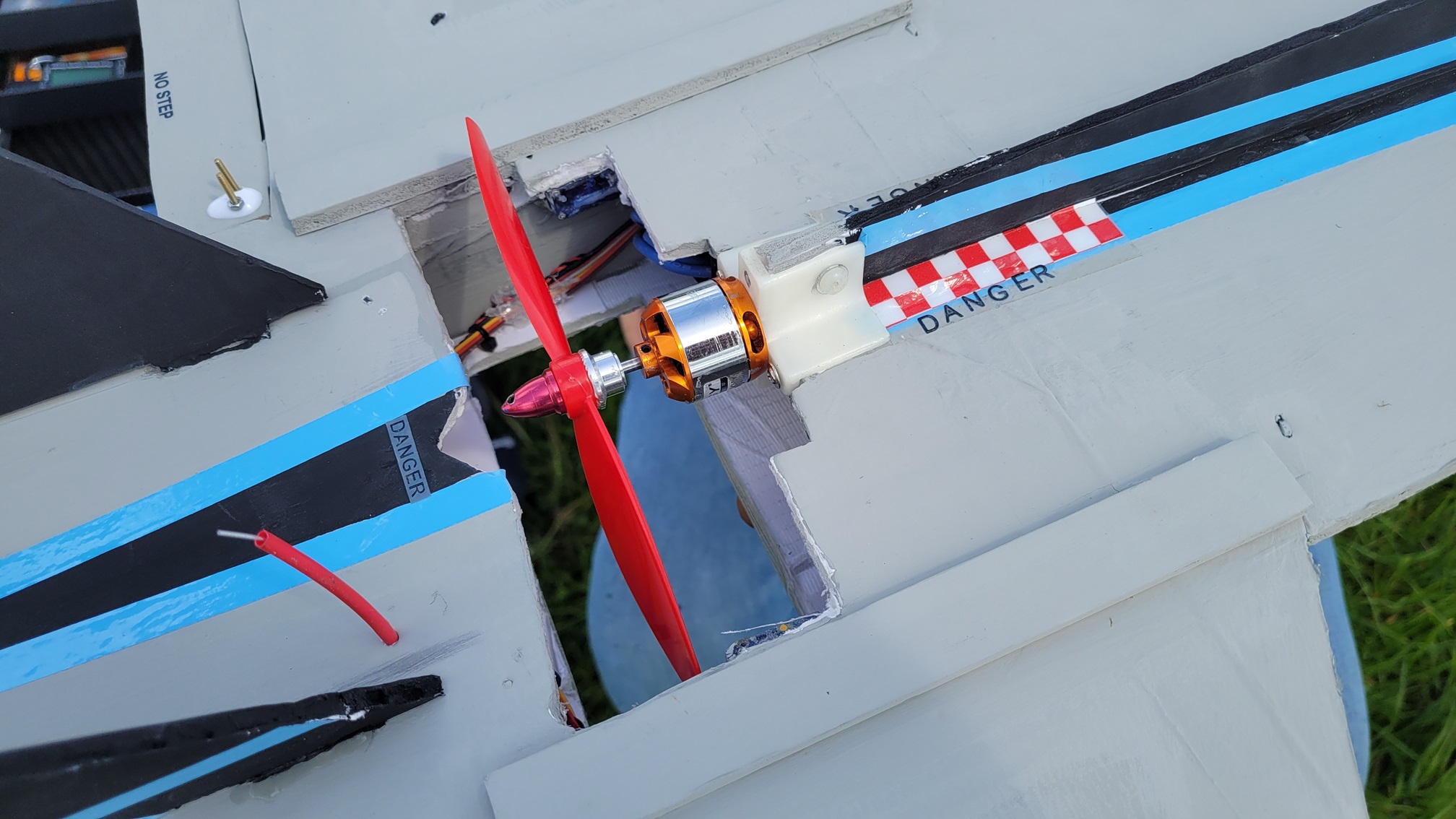 I suggested Dougal Entendre try it to see if he had any ideas and was secretly rather pleased when he had exactly the same result as me, it flew but only just. Dougal suggested a higher kv motor running a smaller prop to give the Hornet more speed so Woody then fitted a T-Motor AS2308 2600kv and a 5” propellor. That produced more speed but the flying characteristics were still ‘interesting’ and it was very noisy, too noisy to use, so Woody is going to try a 6” prop instead. At the moment trials are ongoing so watch this space. The first attempts with the Turnigy motor fitted can be seen in this month’s video.
I suggested Dougal Entendre try it to see if he had any ideas and was secretly rather pleased when he had exactly the same result as me, it flew but only just. Dougal suggested a higher kv motor running a smaller prop to give the Hornet more speed so Woody then fitted a T-Motor AS2308 2600kv and a 5” propellor. That produced more speed but the flying characteristics were still ‘interesting’ and it was very noisy, too noisy to use, so Woody is going to try a 6” prop instead. At the moment trials are ongoing so watch this space. The first attempts with the Turnigy motor fitted can be seen in this month’s video.
At the end of April 1066 and Woody were at the field getting the mower box sorted out for us when some members of the Sky Surfing Club were flying. As neither 1066 nor Woody wanted to fly that day it made no difference to them but it they did note that some of the paragliders flew along the ridge well into the area we would normally be using.
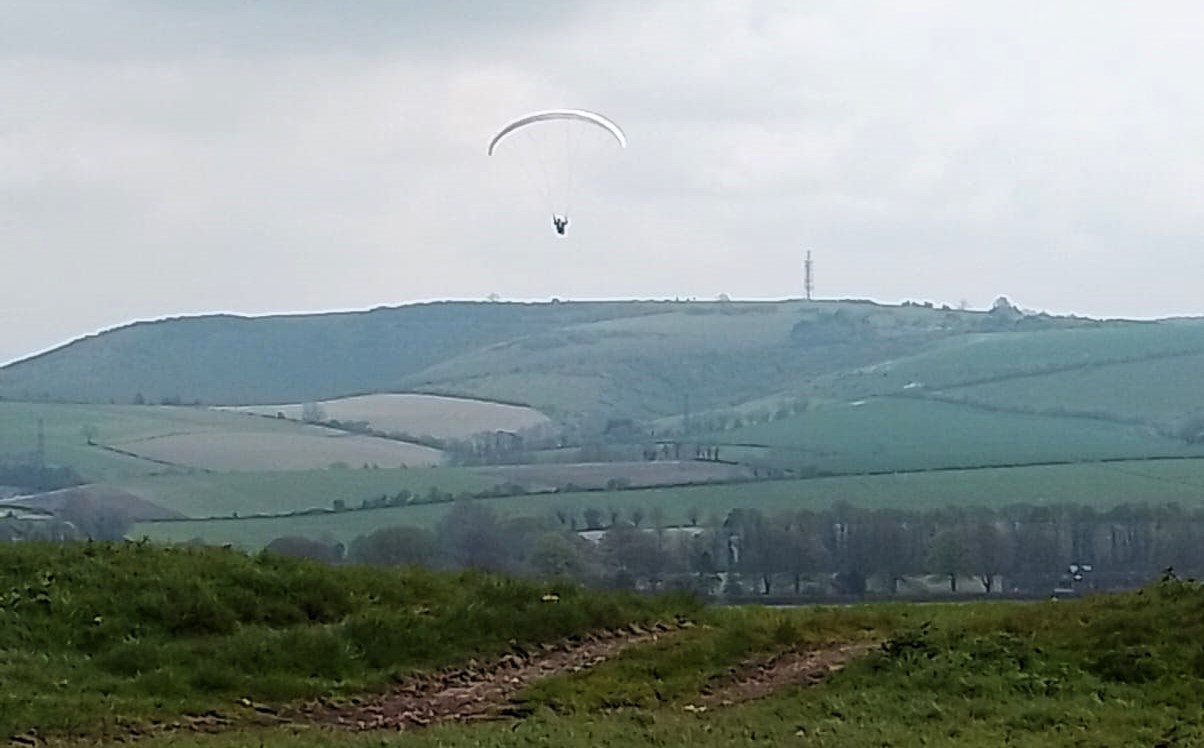
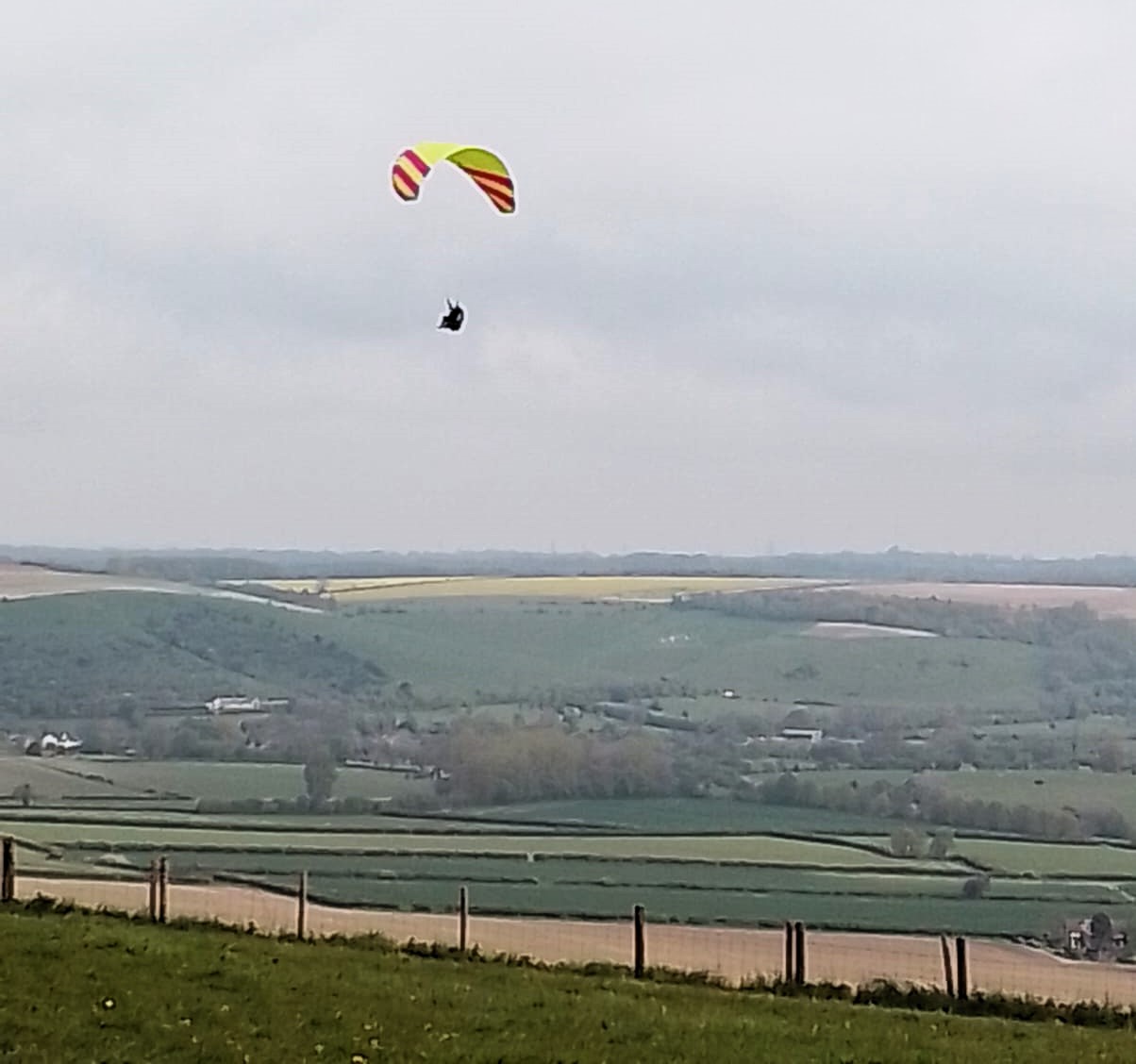 Then one Sunday morning in May we realised the wind direction would be suitable for the Sky Surfers and as we were getting ready to fly we saw a couple of hang glider pilots arrive so we quickly got a few flights in before they launched. It was almost 11.30am before the first one got airborne at which point we all immediately landed and spent the next hour or so watching two hang gliders and two paragliders have some short flights. They came along well into ‘our’ airspace although they stayed fairly well forward over the ridge and model flying could have continued with care to not go forward to anywhere near them.
Then one Sunday morning in May we realised the wind direction would be suitable for the Sky Surfers and as we were getting ready to fly we saw a couple of hang glider pilots arrive so we quickly got a few flights in before they launched. It was almost 11.30am before the first one got airborne at which point we all immediately landed and spent the next hour or so watching two hang gliders and two paragliders have some short flights. They came along well into ‘our’ airspace although they stayed fairly well forward over the ridge and model flying could have continued with care to not go forward to anywhere near them.
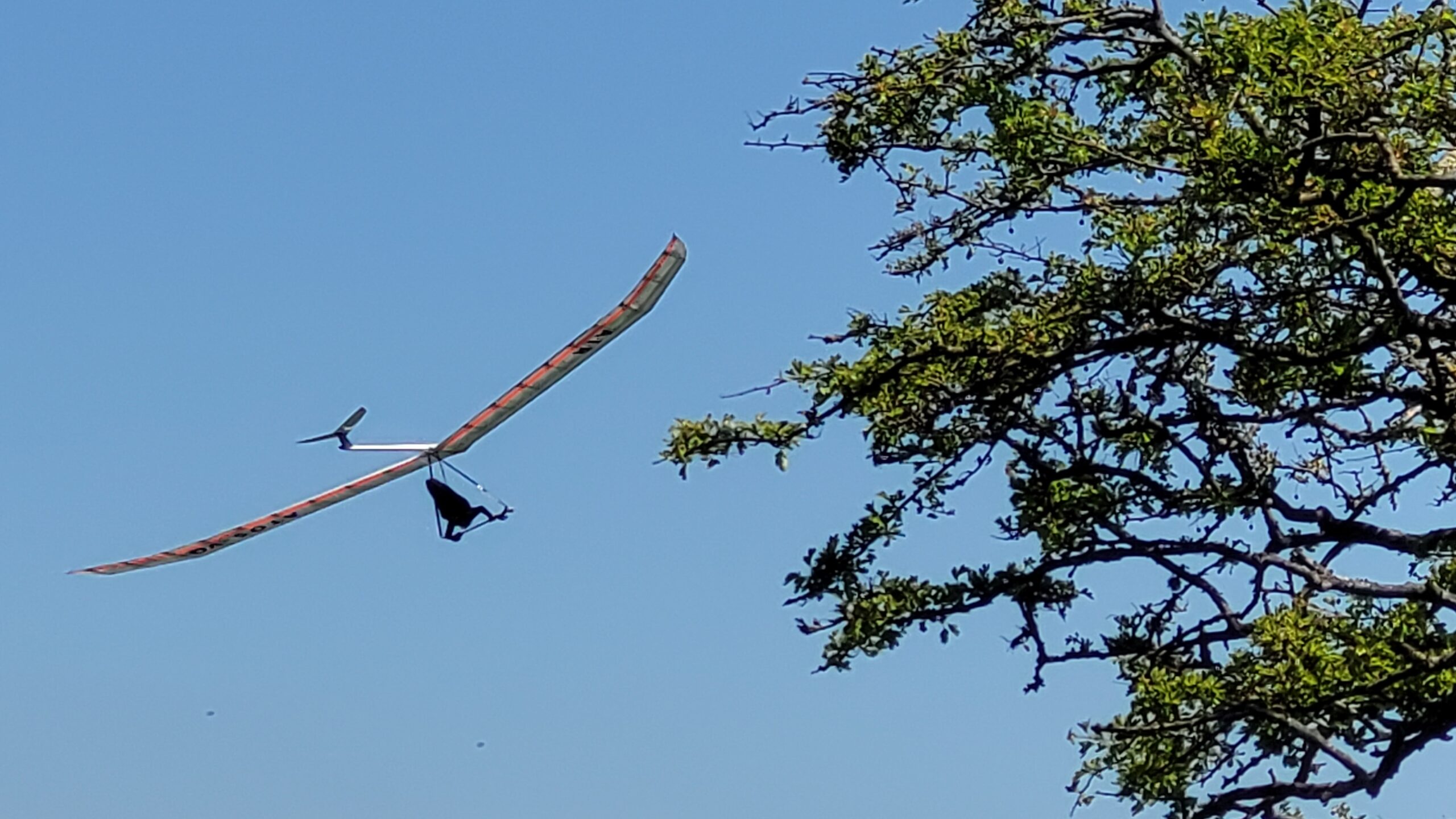
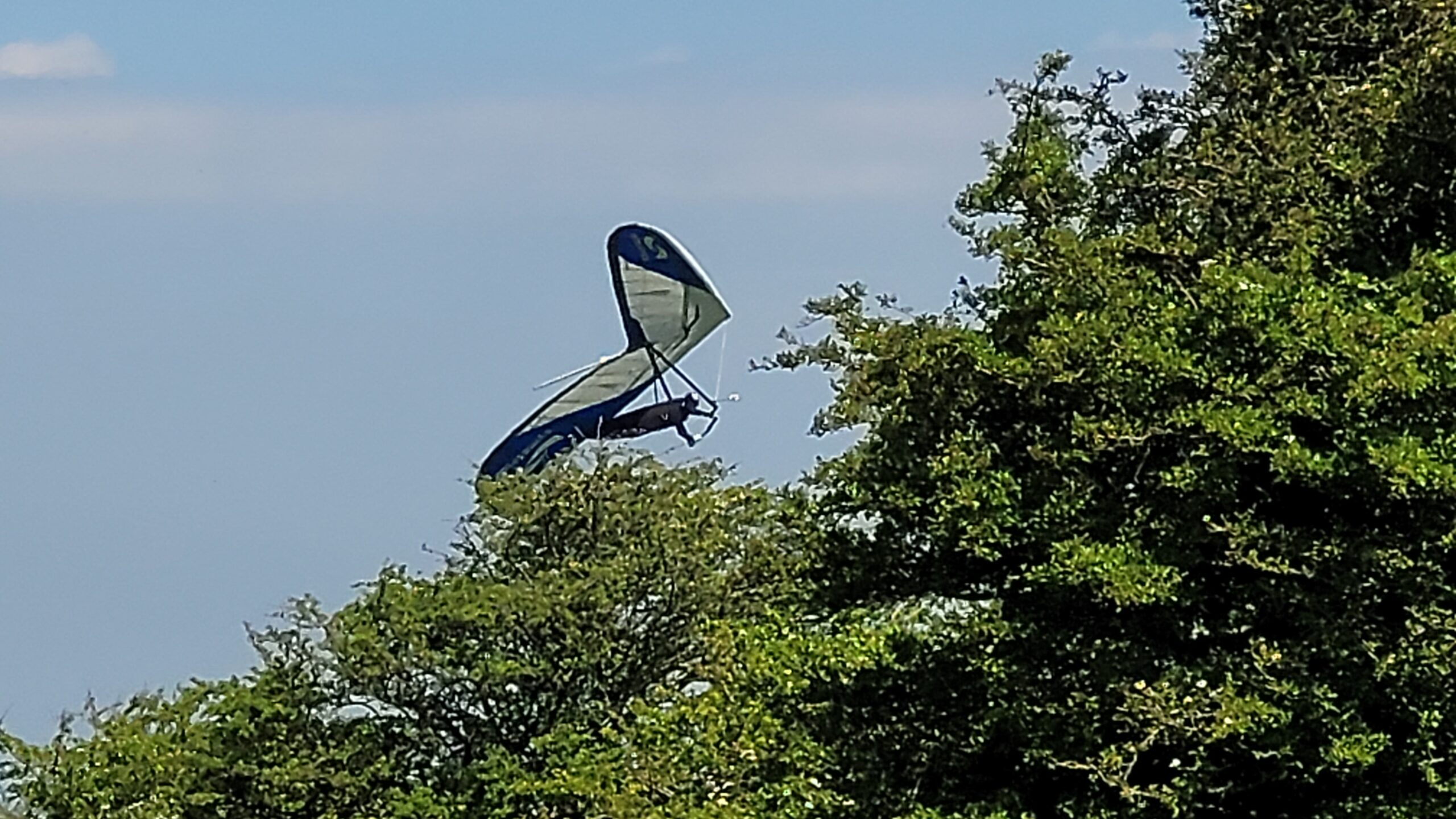 When we packed up 1066 went to chat with them and they explained that the conditions were marginal for them, hence their short flights. They said they would have been happy for us to have continued flying, ideally with a spotter to keep our pilots informed of their whereabouts. Several times the guy flying the blue and white hang glider looked as if he was about to stall and crash but he had come 5th in the World Championships apparently so he certainly knew what he was doing! It was interesting to watch them and as the wind direction is rarely suitable for them to fly I doubt they will be a problem for us very often.
When we packed up 1066 went to chat with them and they explained that the conditions were marginal for them, hence their short flights. They said they would have been happy for us to have continued flying, ideally with a spotter to keep our pilots informed of their whereabouts. Several times the guy flying the blue and white hang glider looked as if he was about to stall and crash but he had come 5th in the World Championships apparently so he certainly knew what he was doing! It was interesting to watch them and as the wind direction is rarely suitable for them to fly I doubt they will be a problem for us very often.
Those of you on the club WhatsApp group will have seen that Gordon Bennett has got his name in lights…well in letters and a photo anyway, when the RCM&E mag published this:
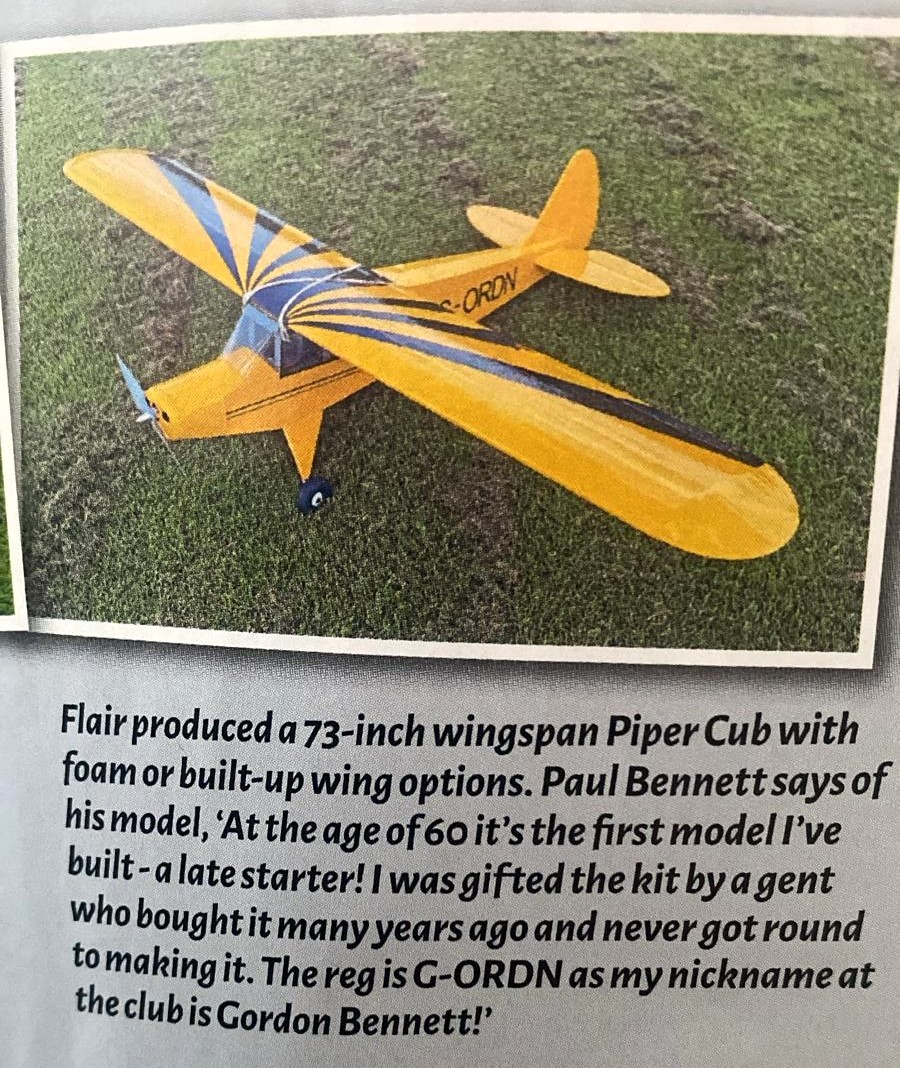 Well done Gordon, it’s good to see you got a mention for PAM…oh hang on, you didn’t!
Well done Gordon, it’s good to see you got a mention for PAM…oh hang on, you didn’t!
Gordon has now got another new plane finished and ready to test fly. Well at around twenty five years old it’s not exactly new, and Gordon didn’t build it… I’ll let him explain:
At the club meeting in October last year Mark kindly ran an auction that included models from John Bourne’s collection. There was a rather beaten-up early monoplane for sale that no one had any interest in. I thought it looked interesting so picked it up for a tenner. The tail plane had fallen off and there were many holes in the tissue covering. 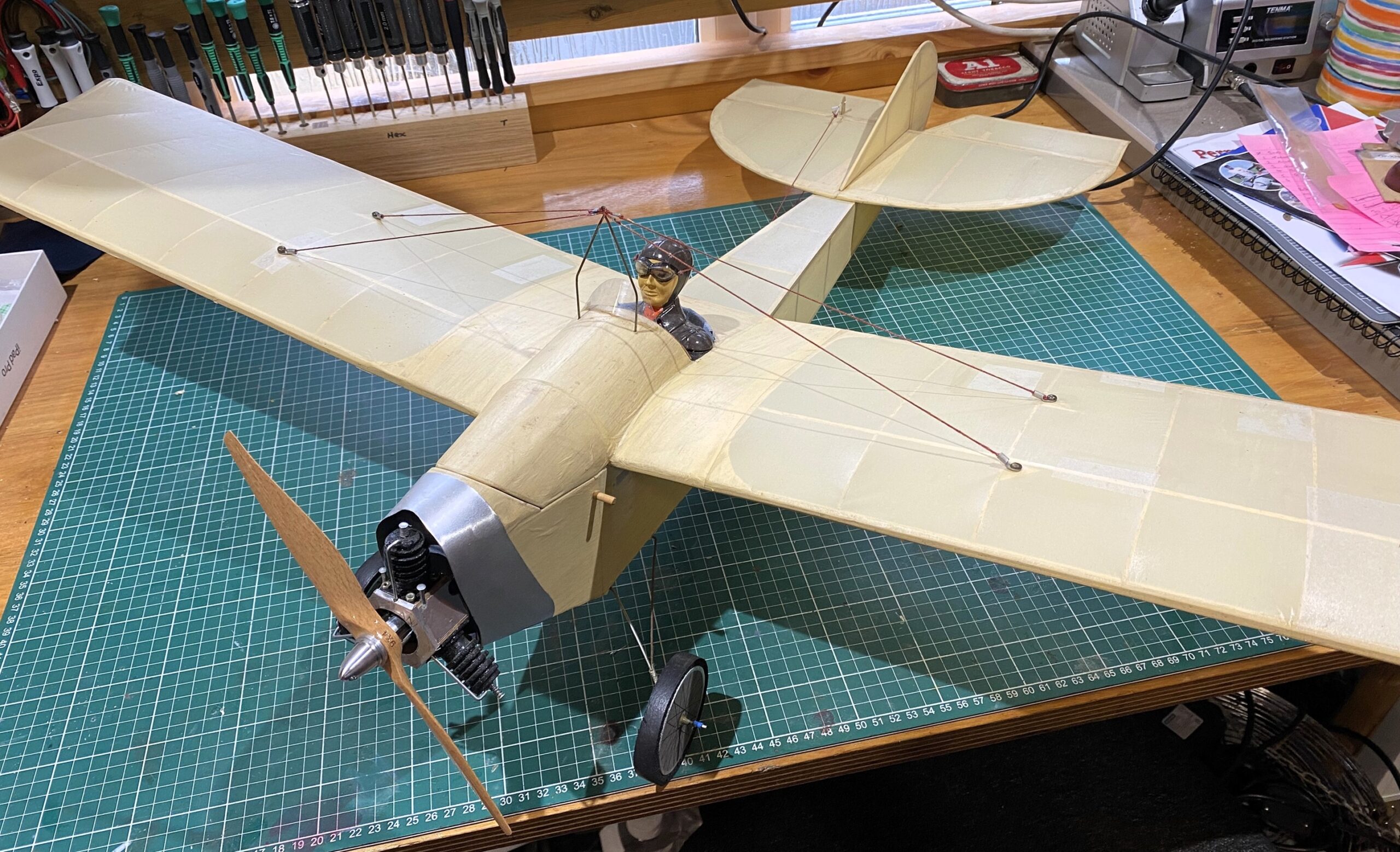 Inspecting the power train exposed kit built around a brushed motor and nicad battery.
Inspecting the power train exposed kit built around a brushed motor and nicad battery.
I hooked it up to my bench power supply to see if it was still running and it jumped into life. Jump is probably a reasonable word to use as the noise and vibration from the gearbox was phenomenal. The whole bench shook and most of my fillings dropped out. So, without any thought or planning I ripped the old setup out intending to go brushless. Some planning would have been prudent as John had built a dummy Anzani 3-cylinder radial around the original motor and gearbox which I definitely wanted to keep.
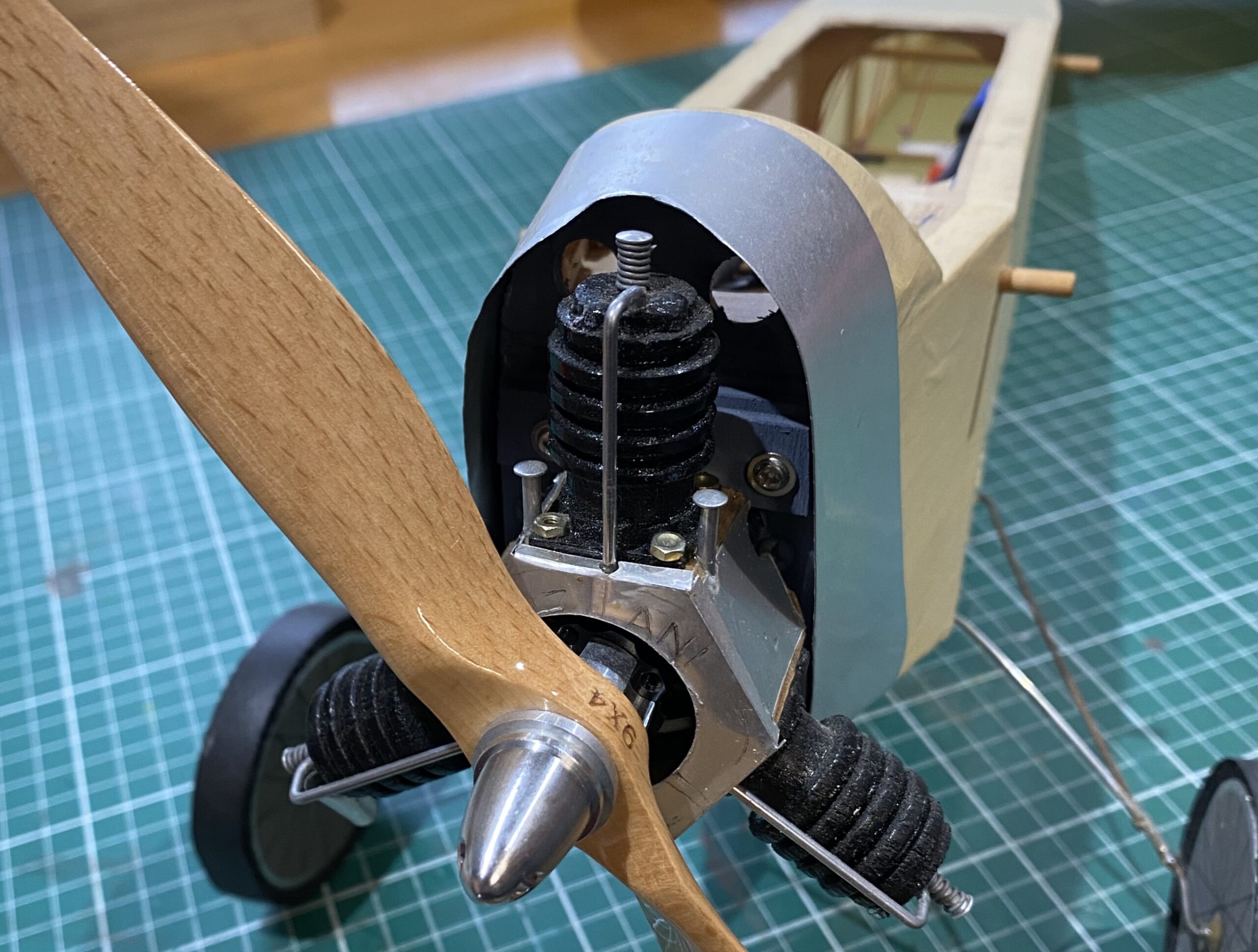 This meant I had a maximum diameter for the brushless motor, I figured I could accommodate varying depths. I got onto the phone and called my new best-mate George at 4-Max. ‘What is it?’ he wanted to know. No idea, I’ll send a photo. How much did it weigh, how much did the old powertrain weigh, had I thought about C of G. Of course I had. Only an idiot would etc etc…. George did his exhaustive questioning and calculating. I pretended everything was carefully planned. To this point we thought the plane might have been something created by John. It was similar to a Deperdussin or Eastbourne Monoplane but nothing matched exactly. Then out of the blue George called and said a mate had come round with an old plans book and they’d found it, a Fosdyke Flyer.
This meant I had a maximum diameter for the brushless motor, I figured I could accommodate varying depths. I got onto the phone and called my new best-mate George at 4-Max. ‘What is it?’ he wanted to know. No idea, I’ll send a photo. How much did it weigh, how much did the old powertrain weigh, had I thought about C of G. Of course I had. Only an idiot would etc etc…. George did his exhaustive questioning and calculating. I pretended everything was carefully planned. To this point we thought the plane might have been something created by John. It was similar to a Deperdussin or Eastbourne Monoplane but nothing matched exactly. Then out of the blue George called and said a mate had come round with an old plans book and they’d found it, a Fosdyke Flyer.
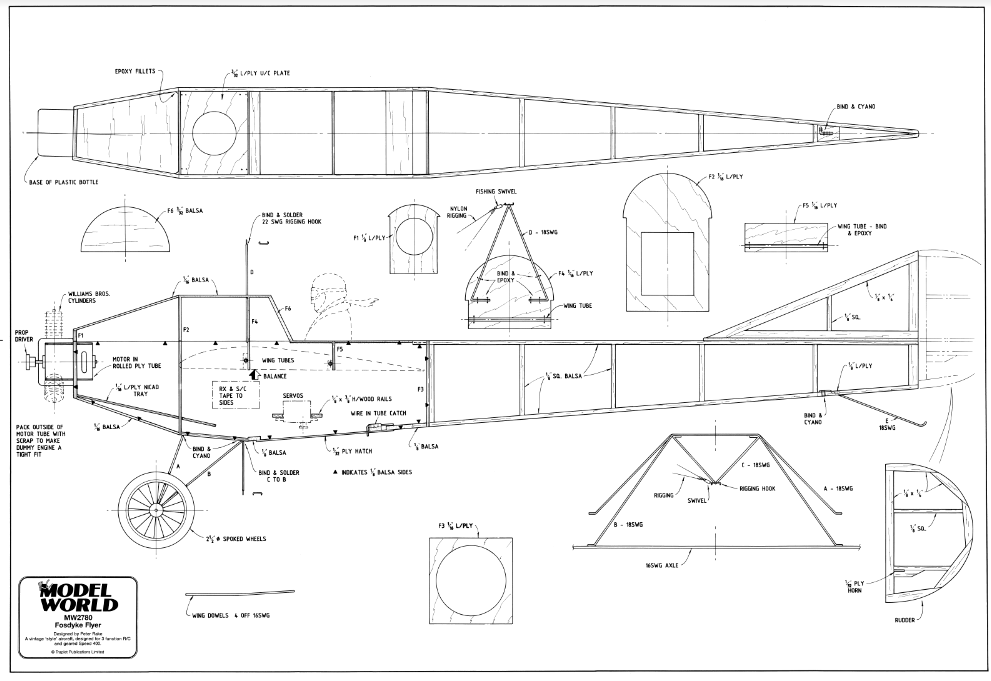
 A free plan had been produced in RC Model World around March 2000. The plans were available on the net and it was clear there was lots of C of G thinking to be done.
A free plan had been produced in RC Model World around March 2000. The plans were available on the net and it was clear there was lots of C of G thinking to be done.
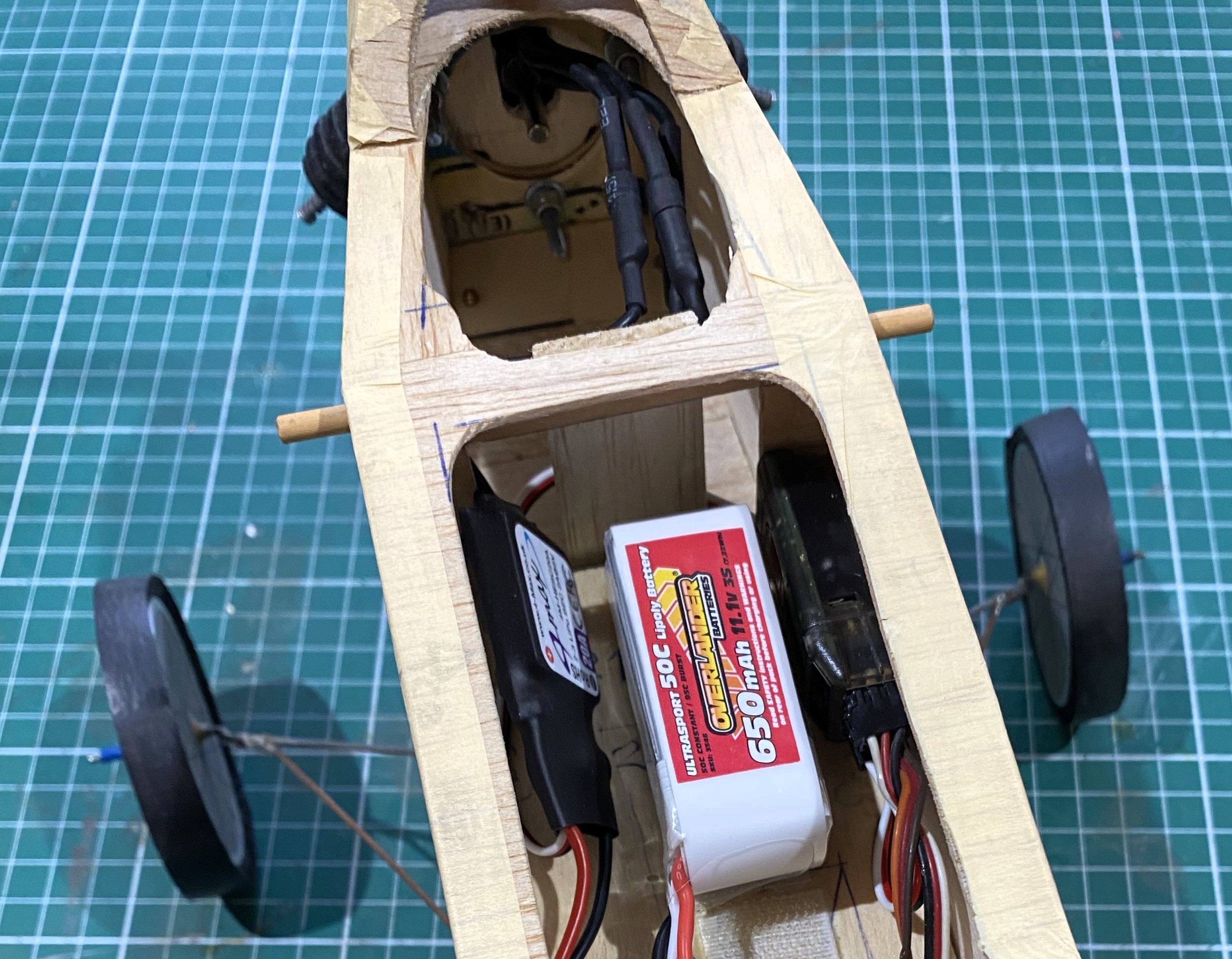 I had to create a new firewall bulkhead as the old motor had robbed me of any new mounting points for the new motor. This allowed me to shove everything as far forward as possible and now the Cof G is just behind the spar. The original article warns to keep the total weight below 25 oz and the author was pretty chuffed as his was just 20 oz. I know John got his in at 23 oz as its written on the plane in biro! With the advent of new technology and much better batteries the new set-up come in at just 16 oz, amazing how much has changed in 25 years. John changed the design a lot by making removable wings, separating the fuselage around the cockpit, also making it easy to get to the radio gear and battery. This does mean there’s no rigging wires on the underside of the wing… I’m assuming he beefed up the main spar at the wing root…. Did anyone ever see it fly?!!
I had to create a new firewall bulkhead as the old motor had robbed me of any new mounting points for the new motor. This allowed me to shove everything as far forward as possible and now the Cof G is just behind the spar. The original article warns to keep the total weight below 25 oz and the author was pretty chuffed as his was just 20 oz. I know John got his in at 23 oz as its written on the plane in biro! With the advent of new technology and much better batteries the new set-up come in at just 16 oz, amazing how much has changed in 25 years. John changed the design a lot by making removable wings, separating the fuselage around the cockpit, also making it easy to get to the radio gear and battery. This does mean there’s no rigging wires on the underside of the wing… I’m assuming he beefed up the main spar at the wing root…. Did anyone ever see it fly?!!
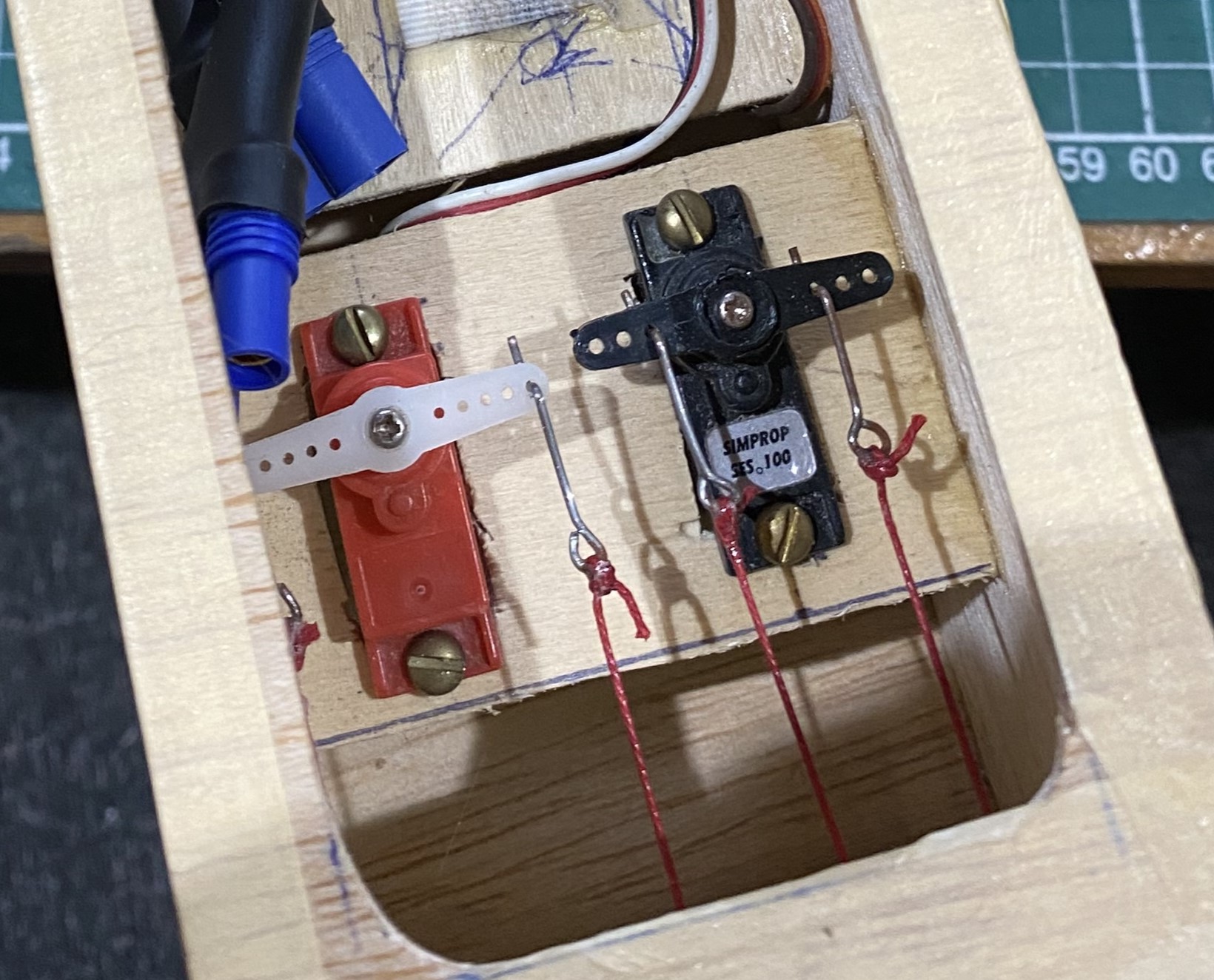 It’s only rudder and elevator (none of those aileron things) and I only intend to fly it on very gentle days. Hopefully at 16 oz’s things won’t get too stressy around the wing root. As they say, watch this space. Thanks for that Gordon, I look forward to seeing it fly.
It’s only rudder and elevator (none of those aileron things) and I only intend to fly it on very gentle days. Hopefully at 16 oz’s things won’t get too stressy around the wing root. As they say, watch this space. Thanks for that Gordon, I look forward to seeing it fly.
If you’re worried about the lack of rigging wires on the underside just fly it inverted!
While I was away MacFly shot lots of video for me to use and he took this screenshot from one of them. The video shows that it was actually just a fleeting pass but the photo makes it look as if 1066 and Dougal are flying an inverted circuit together. 1066 is on top…
I didn’t forget PAM while I was away and I snapped this photo of five Britten-Norman Islanders sat at an airport. I’ve never seen a gaggle of Islanders like this before but as over eight hundred have been built it’s probably not really a particularly unusual sight.
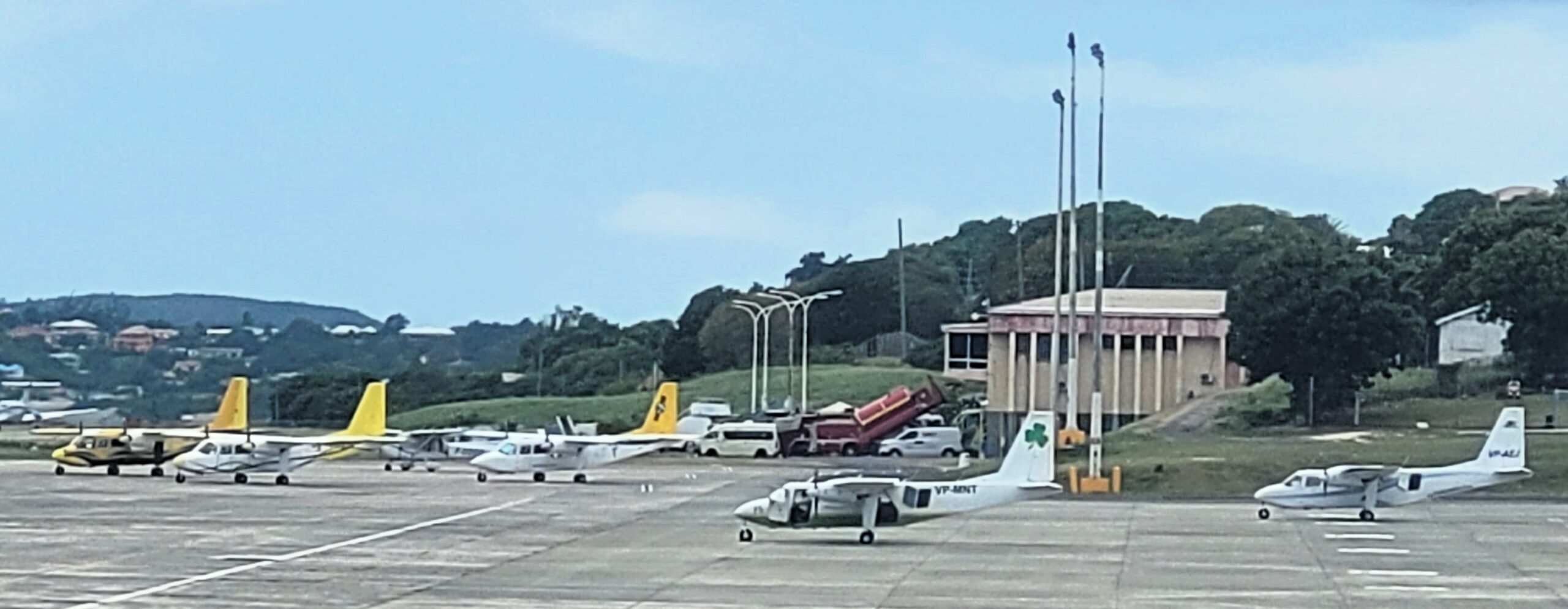 The first one to correctly name the location in the Comments section wins…er…nothing!
The first one to correctly name the location in the Comments section wins…er…nothing!
In the February 2022 Patch News I featured a new model that Woody had just bought, an XFly T-7A Red Hawk. I did the maiden flight and found that it only just got off our patch with the small wheels fitted. A few flights later Woody removed the undercarriage and the Red Hawk flew better after being hand launched and it belly landed with no problems.

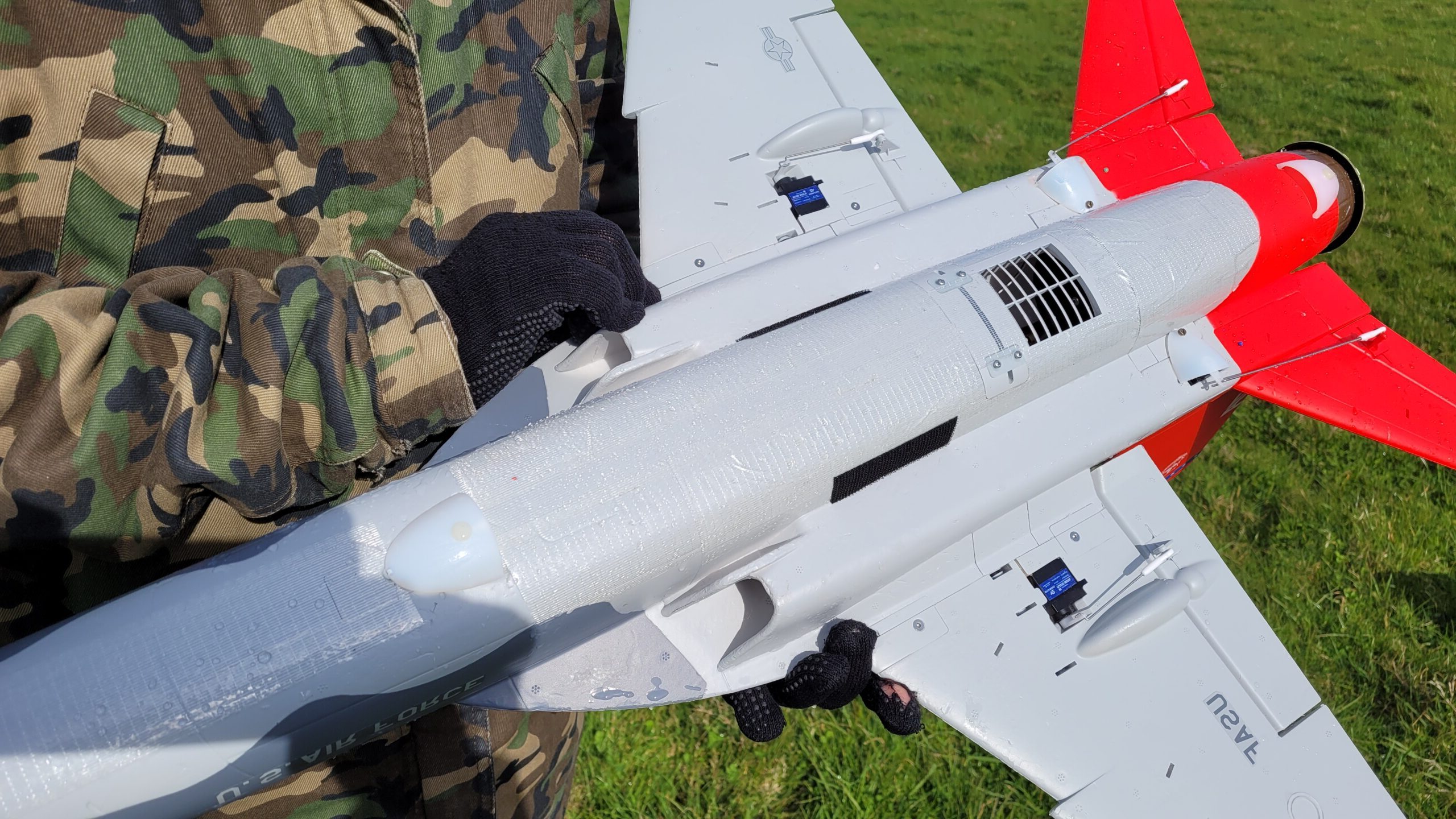 He struggled a bit with flying it himself so fitted an XFly gyro which helped but still found the model a bit of a handful and for the last couple of years it’s mostly been a hangar queen. This month Woody brought it along and I flew it again and it went well enough but I didn’t really feel at ease and Woody chose not to have a go on the controls. It’s sometimes difficult flying other people’s models as you are never sure if they’ve been set up in the best way and with the Red Hawk the gyro was an added complication as Woody was a bit vague about the different switch settings. Following the flight Woody offered it to me for a good price, saying he’d rather see me flying it than have it hanging up in his workshop.
He struggled a bit with flying it himself so fitted an XFly gyro which helped but still found the model a bit of a handful and for the last couple of years it’s mostly been a hangar queen. This month Woody brought it along and I flew it again and it went well enough but I didn’t really feel at ease and Woody chose not to have a go on the controls. It’s sometimes difficult flying other people’s models as you are never sure if they’ve been set up in the best way and with the Red Hawk the gyro was an added complication as Woody was a bit vague about the different switch settings. Following the flight Woody offered it to me for a good price, saying he’d rather see me flying it than have it hanging up in his workshop.
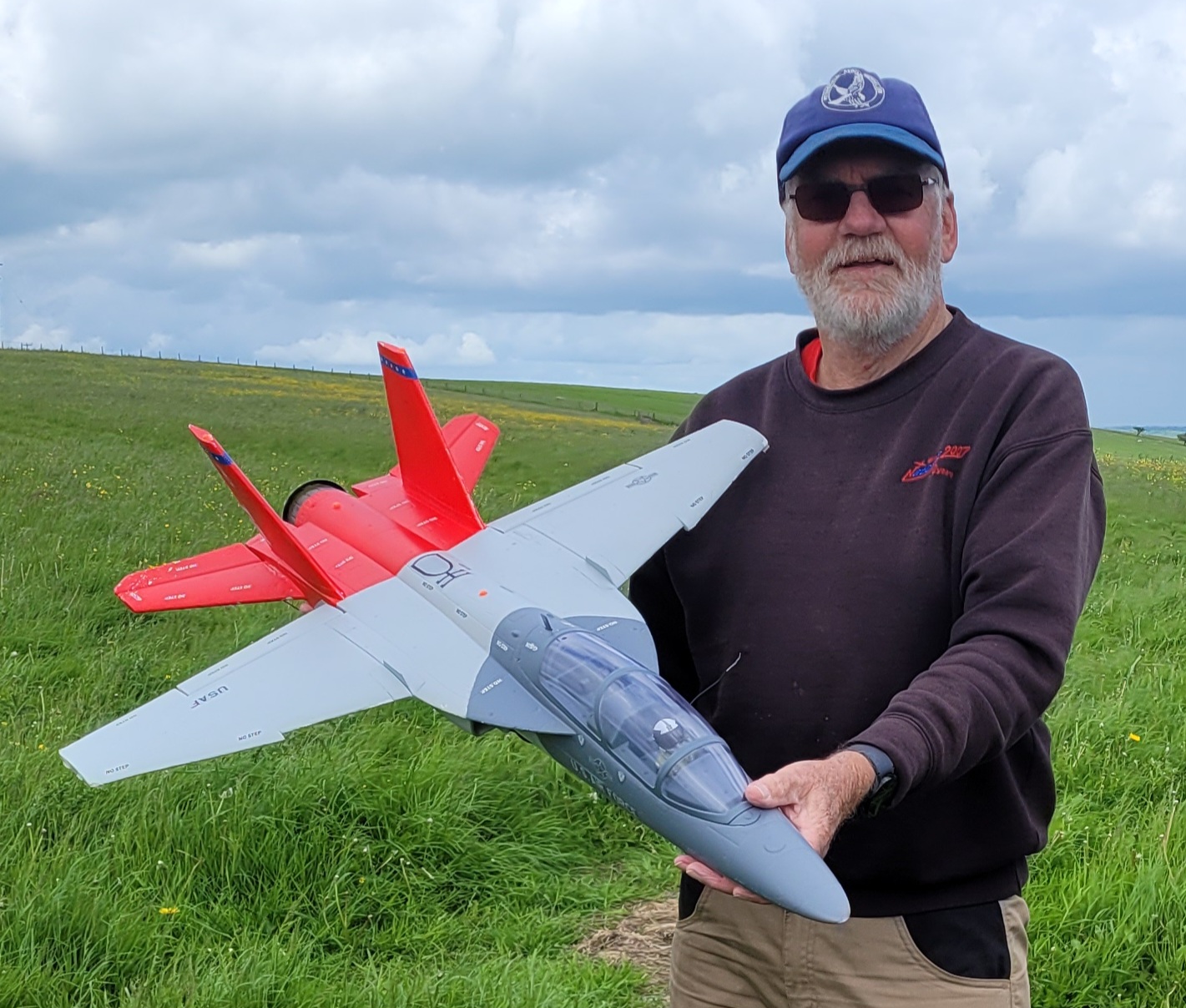 So I took the Red Hawk home and downloaded the manuals for the model and the gyro.
So I took the Red Hawk home and downloaded the manuals for the model and the gyro.
A few hours later I’d replaced Woody’s Spektrum receiver with a Multiplex one and had added the Red Hawk as a new model with the recommended settings on my transmitter.
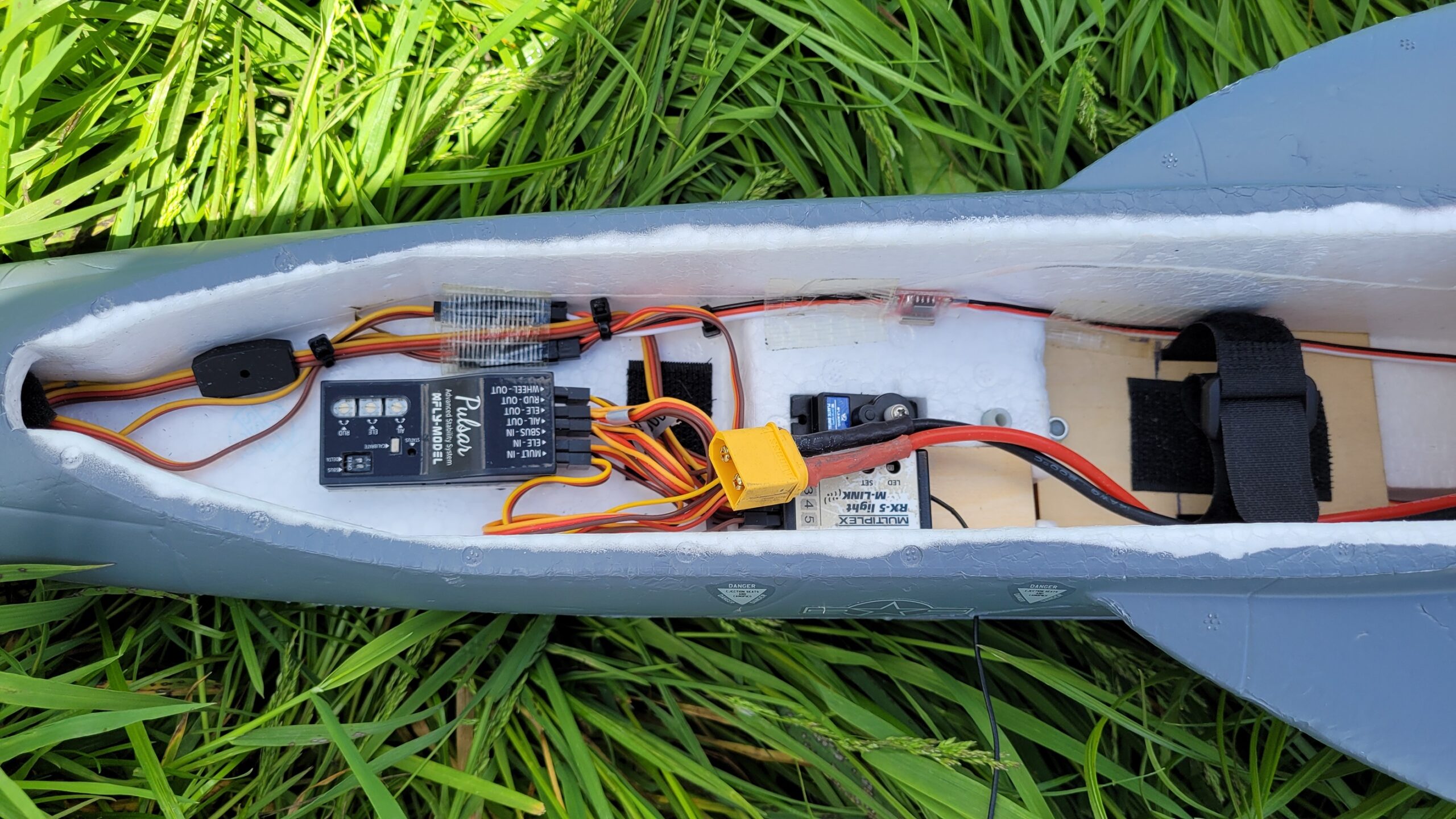 I had also set the gyro up correctly and assigned it to a three position switch with speech leaving no doubt about which mode was which. I have four suitable 4 cell 2200mAh batteries so I charged them up and the following day I had four flights with no problems, just a few small setting changes after each flight to get the characteristics to my liking.
I had also set the gyro up correctly and assigned it to a three position switch with speech leaving no doubt about which mode was which. I have four suitable 4 cell 2200mAh batteries so I charged them up and the following day I had four flights with no problems, just a few small setting changes after each flight to get the characteristics to my liking.
On 17th May 1066 reached the grand old age of 65 and he promised to bring us some cakes at the patch, but he failed to deliver so as a penance I’ve made him write for Patch News: Over the last month or so I have had a hankering for an out and out fun fly model. Searching the internet did not give many options, i.e. Weston UK Cougar, Slec Limbo dancer, Balsa Cabin Funfly. However there was one other that looked interesting, this was Evolution Models Fusion range, which comprises the Micro Fusion, Fusion V2, Fusion V3, and the Mega Fusion. To be honest I don’t like the look of the model, but the V2 had won everything in it’s class in the UK during the 2019 season, and was the mid-priced option at £99.00 plus £9.99 delivery so this is the version I decided to buy, the order was placed, and the model duly arrived a few days later. Not so long ago you could spend a lot less and the postman would be completely hidden by the box of your new toy so the skinny one that arrived was a bit of disappointment. I suppose it’s bigger than the plastic bag it could end up in. Disappointment aside let’s see what’s inside.
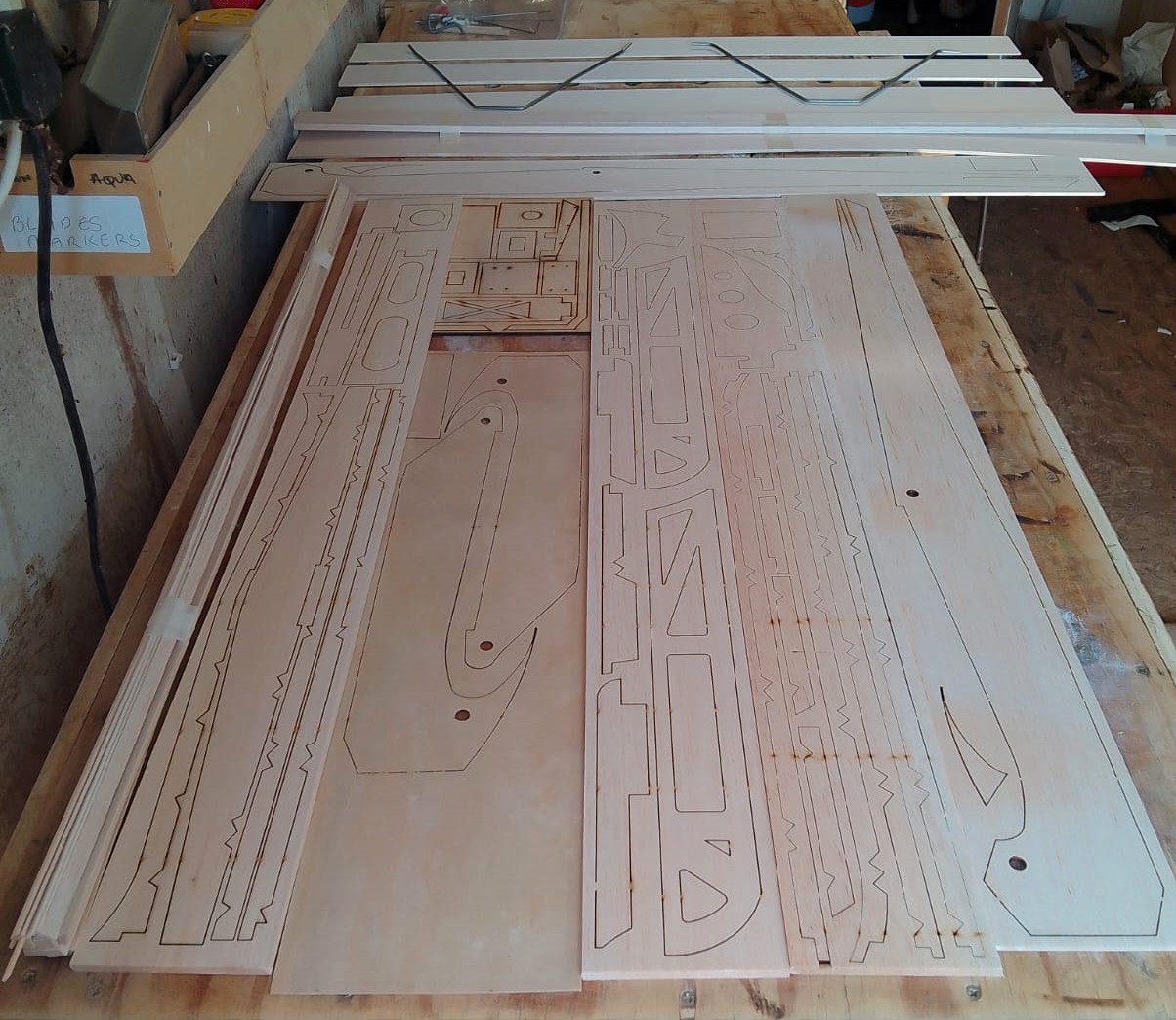 Or not as it turns out, starting with what you don’t get, there are no instructions you have to download these as a PDF, there is no plan, that’s right, there really is no plan at all, and no wheels. You do get a box of strip wood, sheet stock, a bag of good quality hardware, and some very nice laser cut parts, in both ply and 6mm balsa, all of which has been graded perfectly for its respective job. The laser cutting is superb, with 1.5mm tabs holding the parts in place. A small criticism is none of the parts are numbered, also the parts needed to build the tailplane for instance, are all on different sheets, so it took me a little time using the PDF instructions on my phone to identify all the parts.
Or not as it turns out, starting with what you don’t get, there are no instructions you have to download these as a PDF, there is no plan, that’s right, there really is no plan at all, and no wheels. You do get a box of strip wood, sheet stock, a bag of good quality hardware, and some very nice laser cut parts, in both ply and 6mm balsa, all of which has been graded perfectly for its respective job. The laser cutting is superb, with 1.5mm tabs holding the parts in place. A small criticism is none of the parts are numbered, also the parts needed to build the tailplane for instance, are all on different sheets, so it took me a little time using the PDF instructions on my phone to identify all the parts.
The other unusual feature is the wing ribs are made of Depron.
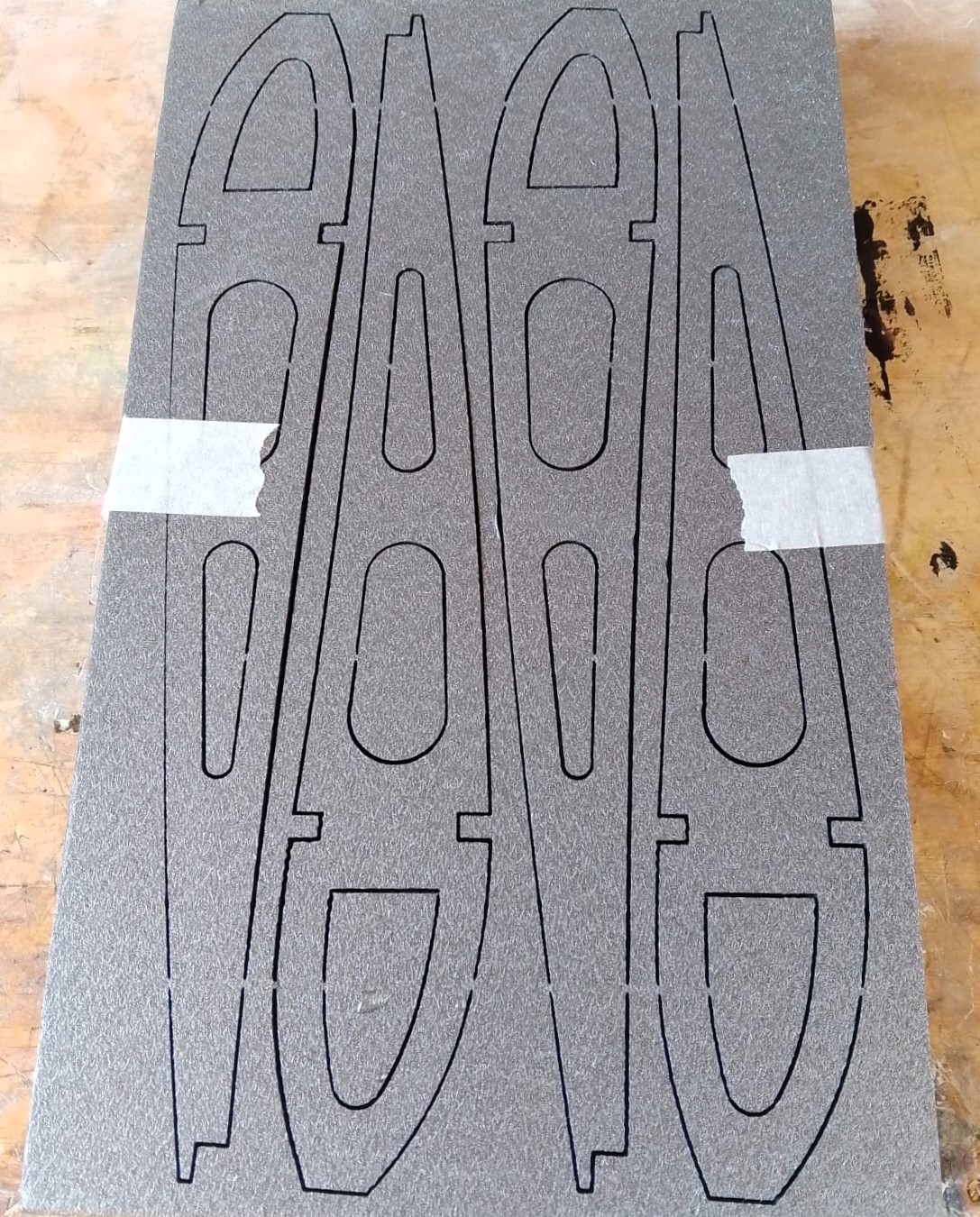 With all the materials laid out on the bench, I felt a bit better about my £110.00 spend, and when you take into account the amount of thought the designers have given to producing a traditional builders kit, but have removed the hassle of cutting out all the fiddly parts, it’s not so bad. I decided to start the build with the tail feathers, having identified the parts required they were released from the sheets, and as can be seen in the photos, needed almost no fettling to make them fit. My next concern was the amount of carbon on the edges of these parts where they join, may affect the integrity of the joint.
With all the materials laid out on the bench, I felt a bit better about my £110.00 spend, and when you take into account the amount of thought the designers have given to producing a traditional builders kit, but have removed the hassle of cutting out all the fiddly parts, it’s not so bad. I decided to start the build with the tail feathers, having identified the parts required they were released from the sheets, and as can be seen in the photos, needed almost no fettling to make them fit. My next concern was the amount of carbon on the edges of these parts where they join, may affect the integrity of the joint.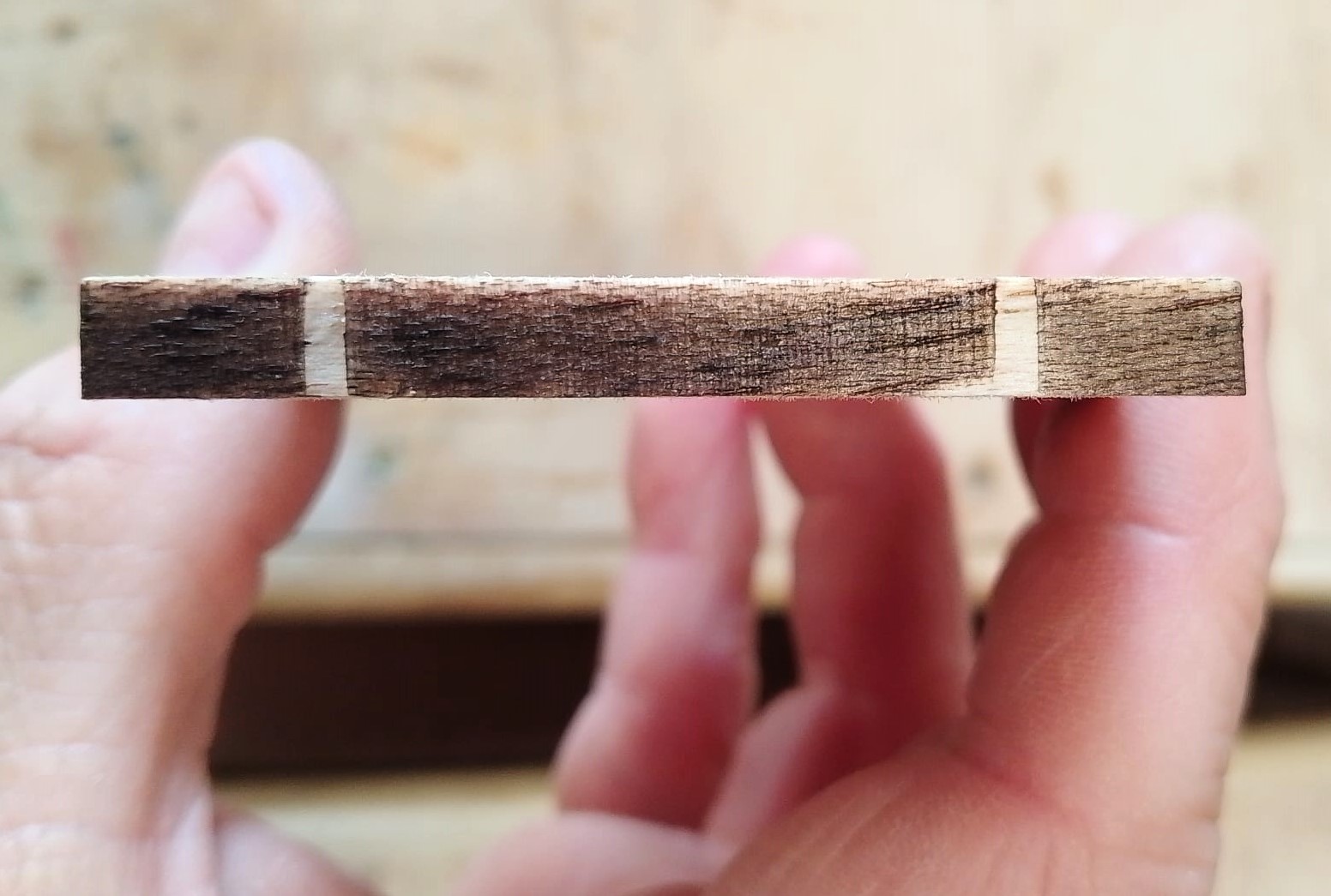
I felt it would be a shame to spoil those perfectly square edges trying to remove the carbon with sand paper, so I tried joining some scrap with super glue without removing the carbon, and I’m happy to report the joint strength was more than adequate.
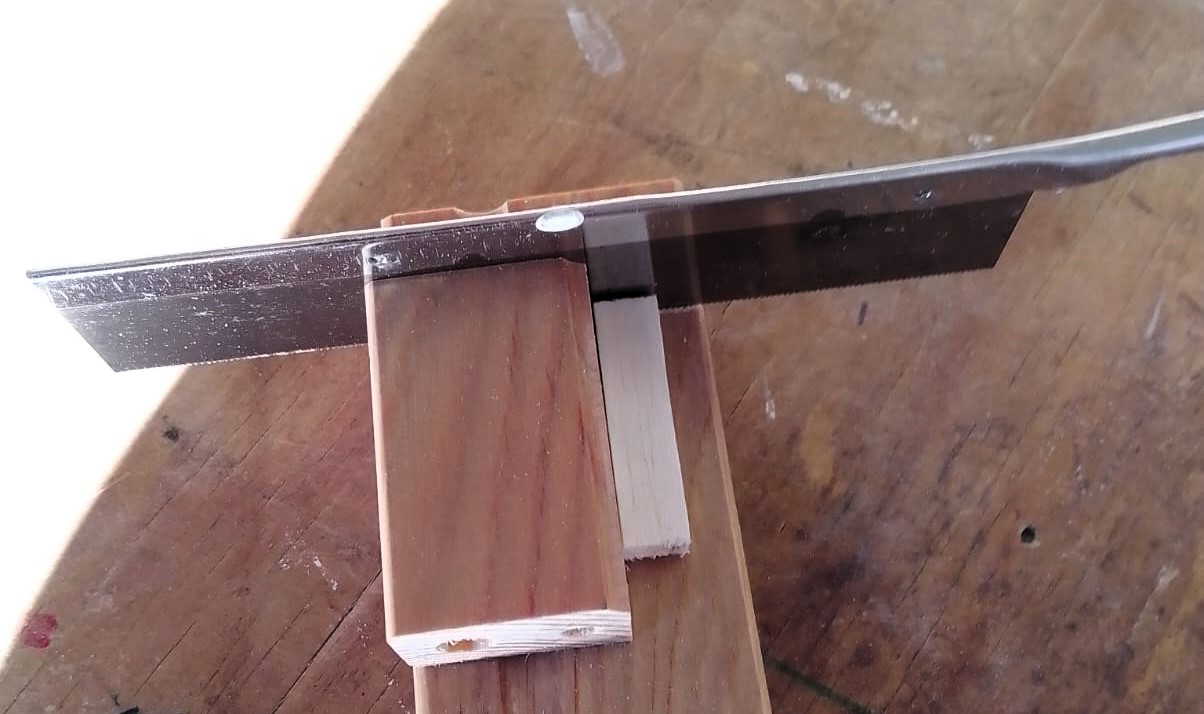 The outline of the tail and elevator is made up from 10 laser cut parts plus cross bracing cut from 9 x 6mm soft wood strip. I don’t own a mitre block for my razor saw so after a minute’s thinking and another minute with the chop saw I made a little cutting jig, which made cutting nice square ends on the cross bracing a breeze. Two hours after opening the box, including taking photos etc, I had a completed tail.
The outline of the tail and elevator is made up from 10 laser cut parts plus cross bracing cut from 9 x 6mm soft wood strip. I don’t own a mitre block for my razor saw so after a minute’s thinking and another minute with the chop saw I made a little cutting jig, which made cutting nice square ends on the cross bracing a breeze. Two hours after opening the box, including taking photos etc, I had a completed tail.
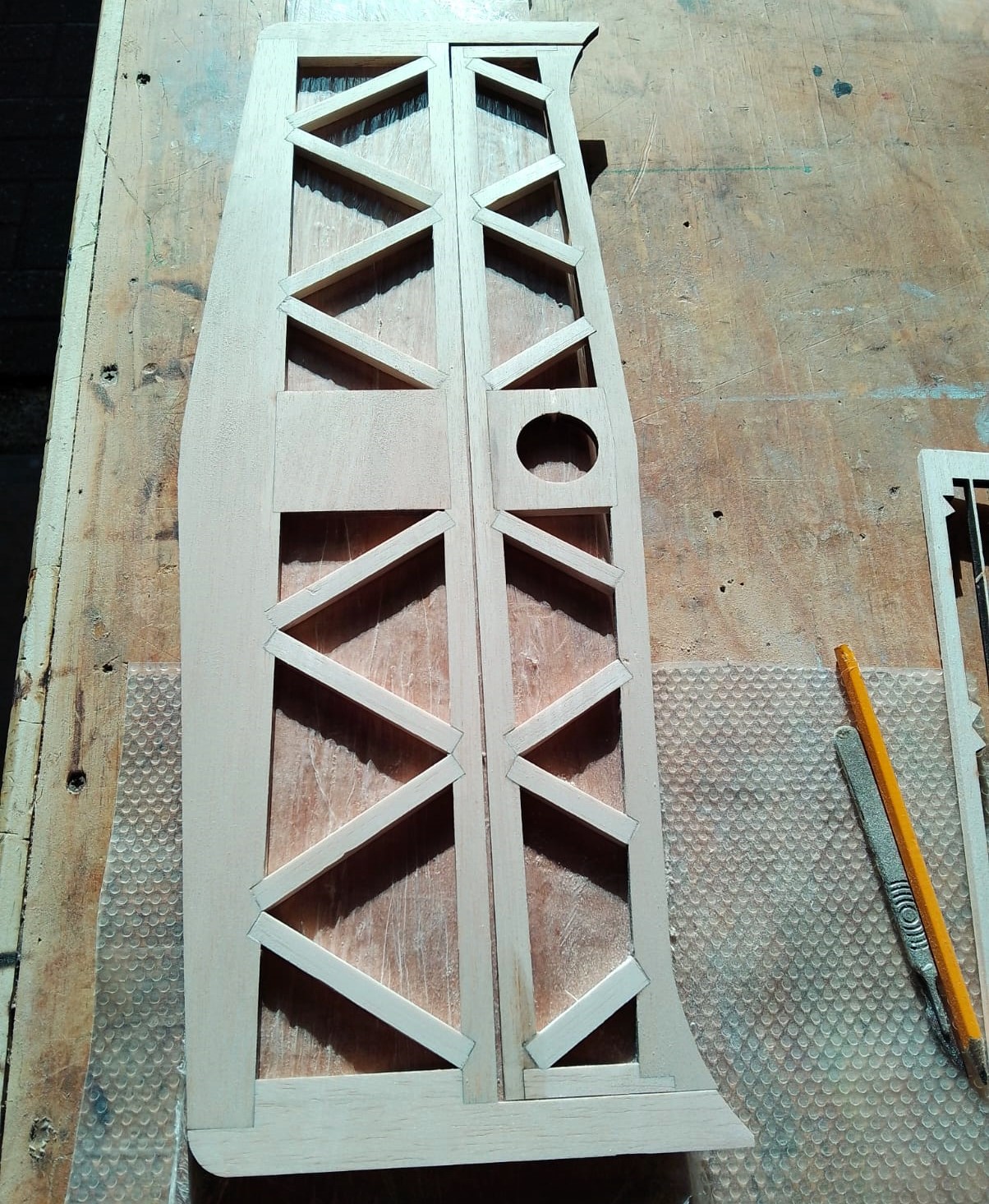 Thanks 1066, it looks good so far and I’m looking forward to next month’s instalment.
Thanks 1066, it looks good so far and I’m looking forward to next month’s instalment.
We can always rely on Norwegian Nick to produce a beautifully finished model and in May he turned up to fly with an exceptional one, a very realistic two metre wingspan Eagle!

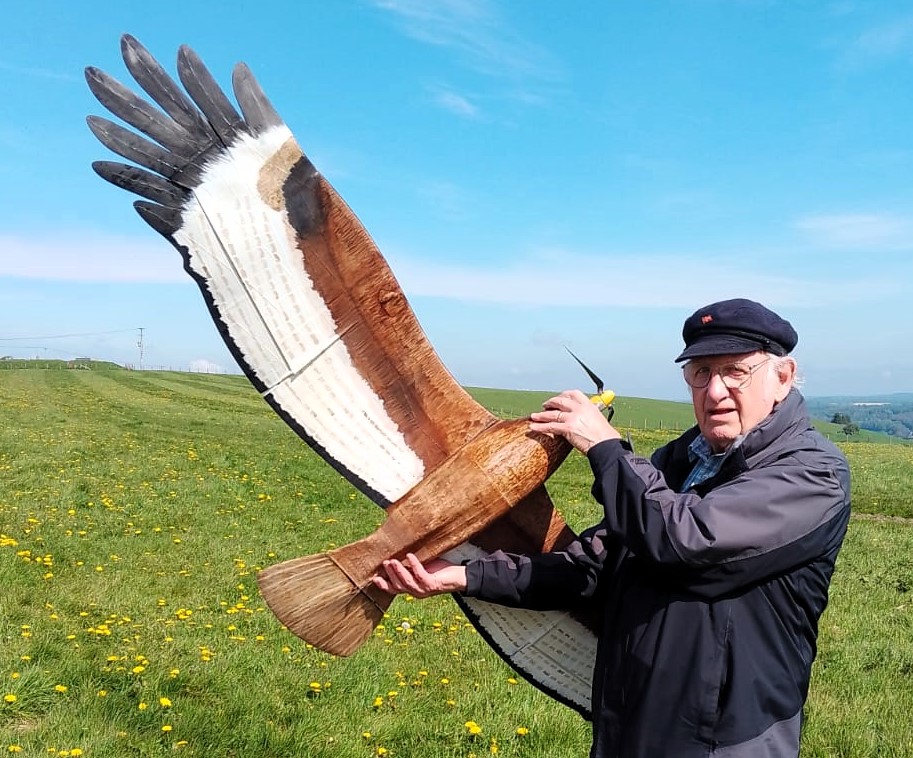 The design is from the Plane Print website (planeprint.com/eagle) and it’s a 3D printed plastic model. There are a lot of parts and they were all printed for Nick by his son Shaun.
The design is from the Plane Print website (planeprint.com/eagle) and it’s a 3D printed plastic model. There are a lot of parts and they were all printed for Nick by his son Shaun. 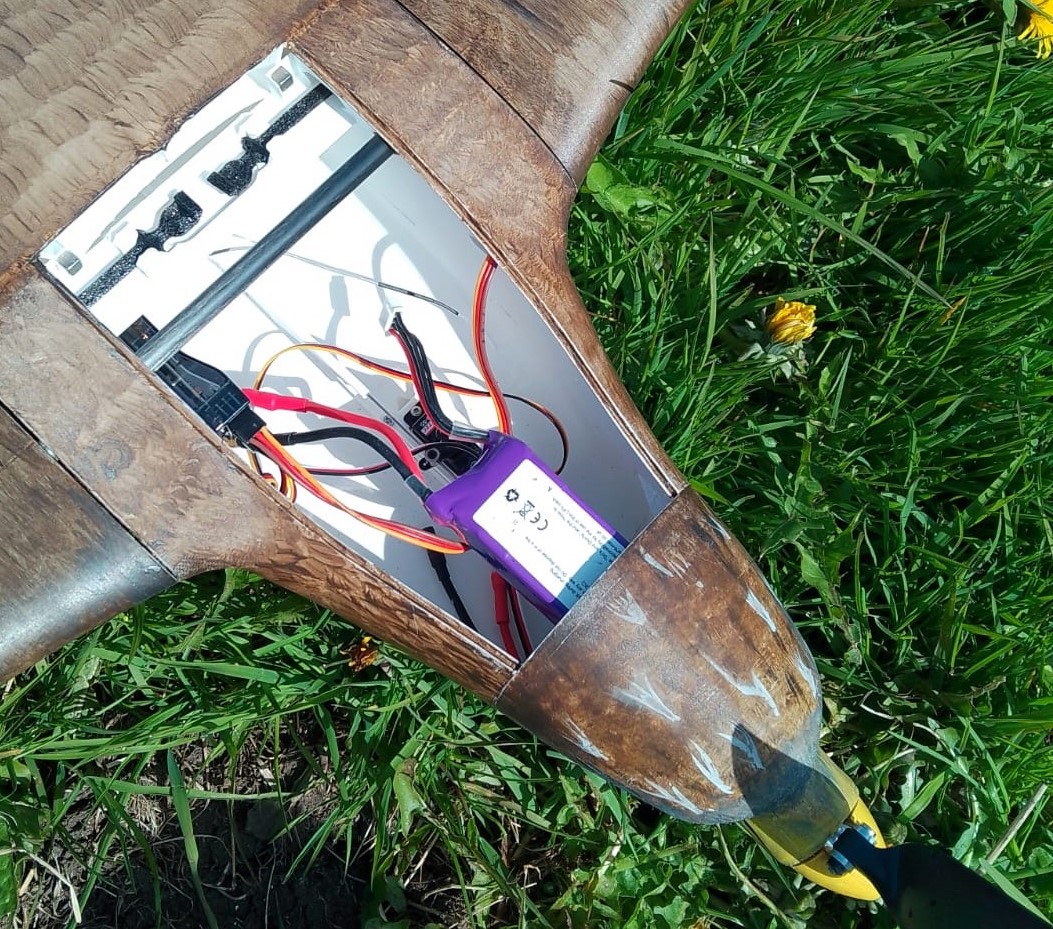 You really need to visit the website to see how it’s done, there’s loads of info including a build by a guy named Troy MacMillan who does a video of him constructing and flying it. The plastic is white so Nick had to do all the painting and he made a fantastic job of it.
You really need to visit the website to see how it’s done, there’s loads of info including a build by a guy named Troy MacMillan who does a video of him constructing and flying it. The plastic is white so Nick had to do all the painting and he made a fantastic job of it.
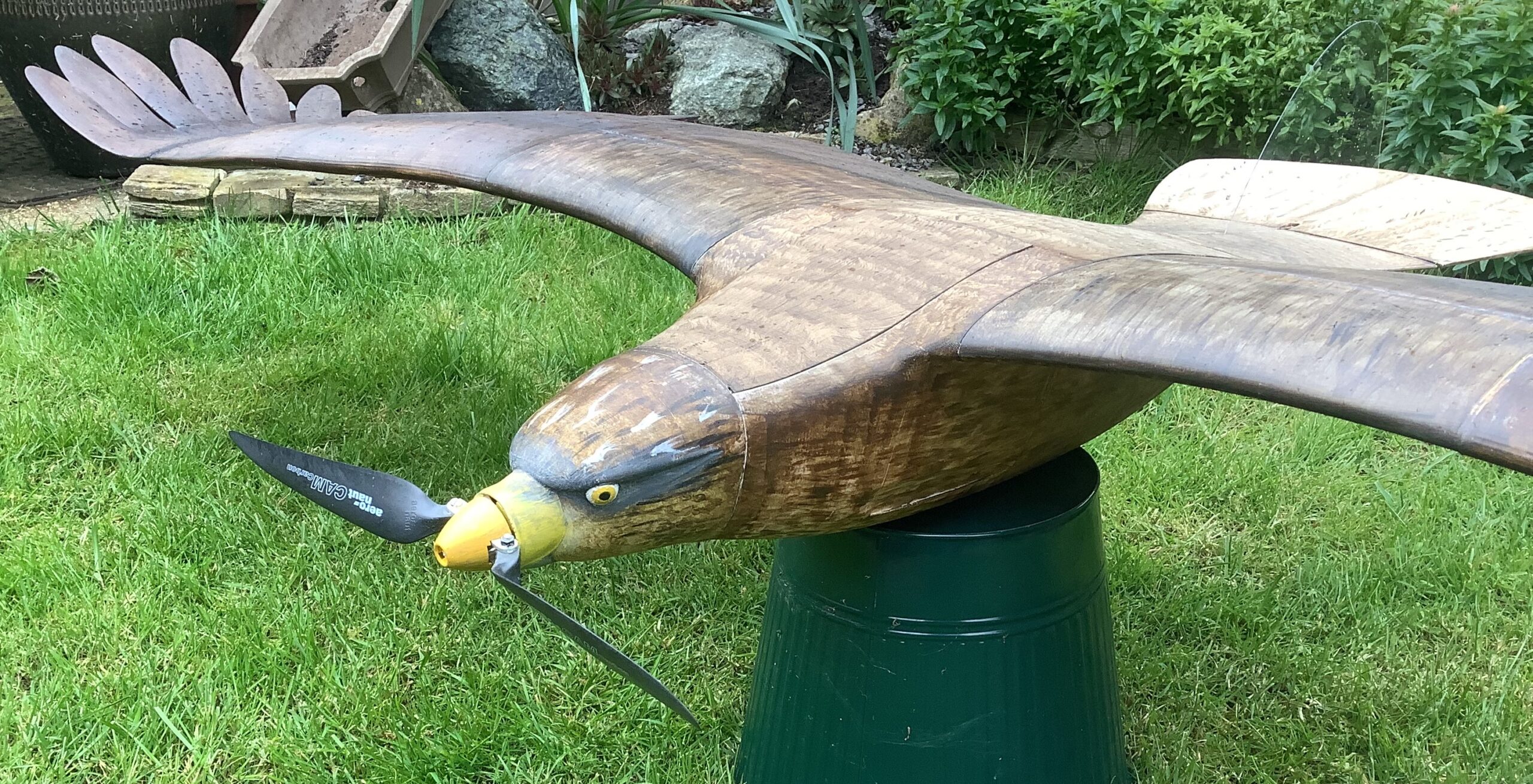
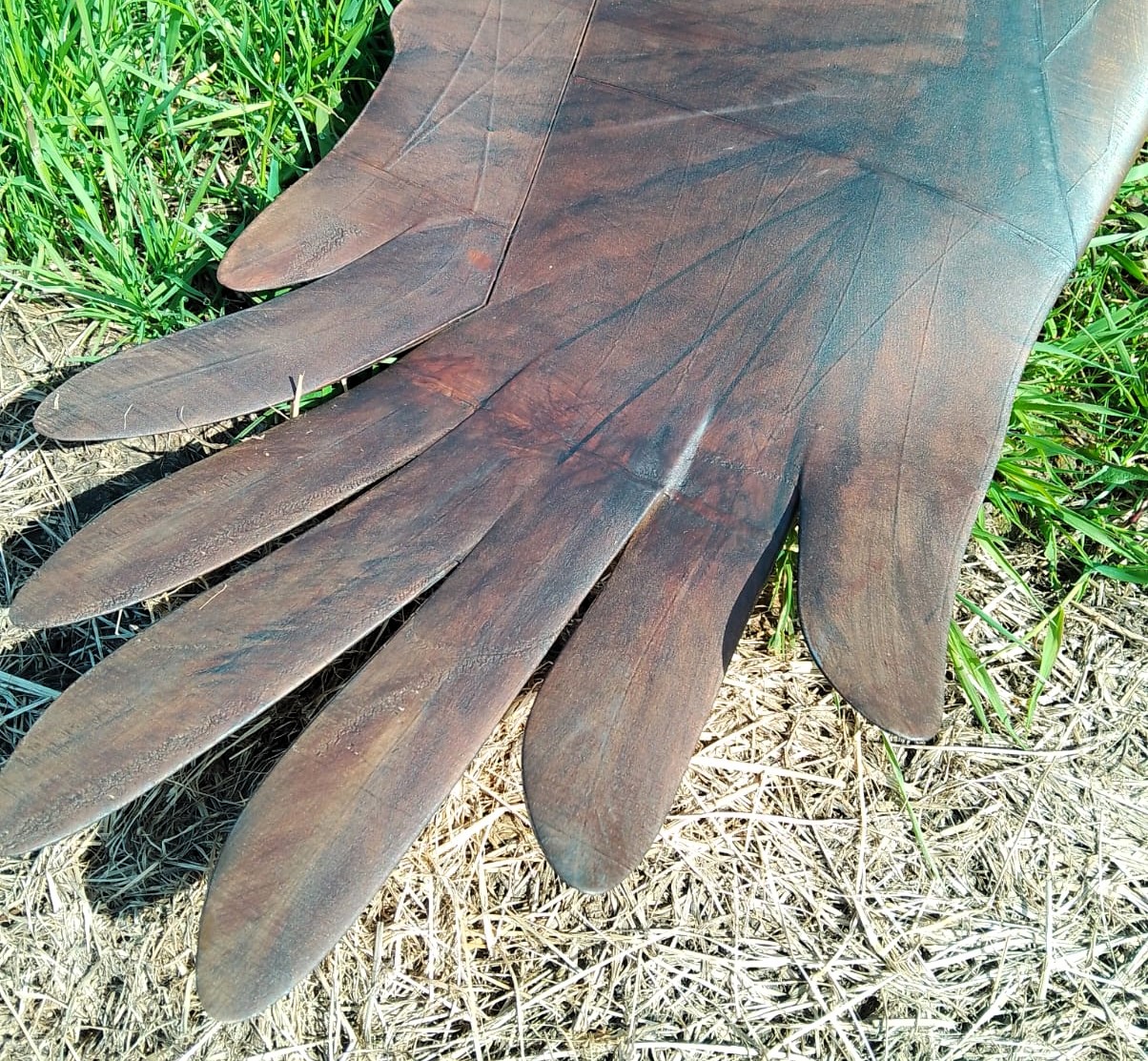 On it’s maiden flight the Eagle went away from the launch but unfortunately crashed shortly afterwards. This is what Nick says: On the test flight, after launch I was trying to trim it out but it started to do its own thing, loop the loop and was uncontrollable.
On it’s maiden flight the Eagle went away from the launch but unfortunately crashed shortly afterwards. This is what Nick says: On the test flight, after launch I was trying to trim it out but it started to do its own thing, loop the loop and was uncontrollable. 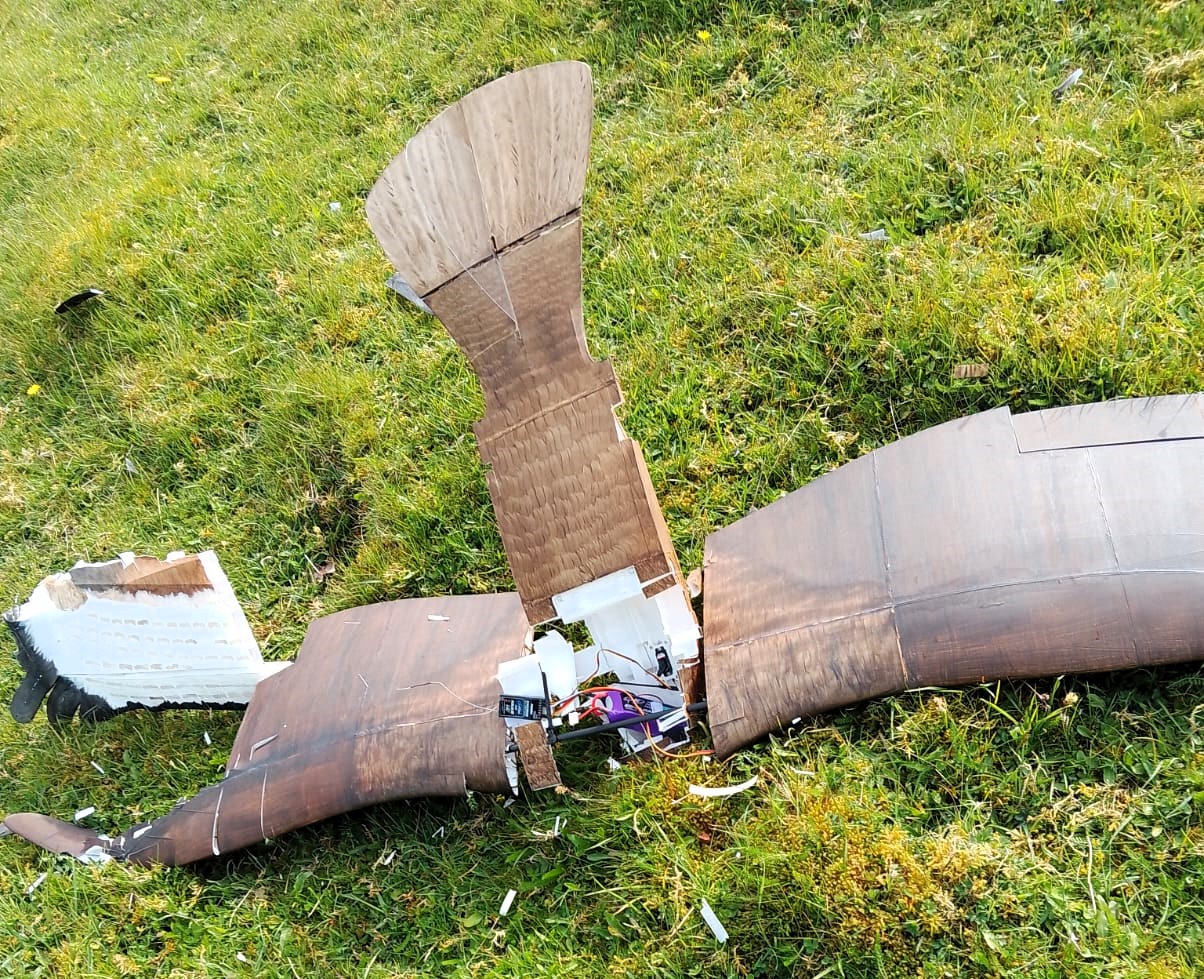 Anyway it buried itself in the valley and is non-repairable. Everything went into a bin liner and I took it home. All servos, motor and battery were salvaged but when I went to take out the aileron servo I noticed that the grub screw which held the pushrod attached to the servo arm was missing. Aargh, I think the unfortunate missing screw explains everything Nick but at least the cause of the crash is probably known. Nick says that he’s hoping Shaun will print him a replacement next month, I’m looking forward to seeing it.
Anyway it buried itself in the valley and is non-repairable. Everything went into a bin liner and I took it home. All servos, motor and battery were salvaged but when I went to take out the aileron servo I noticed that the grub screw which held the pushrod attached to the servo arm was missing. Aargh, I think the unfortunate missing screw explains everything Nick but at least the cause of the crash is probably known. Nick says that he’s hoping Shaun will print him a replacement next month, I’m looking forward to seeing it.
Here are a few excellent action shots that Kryten kindly took for us this month: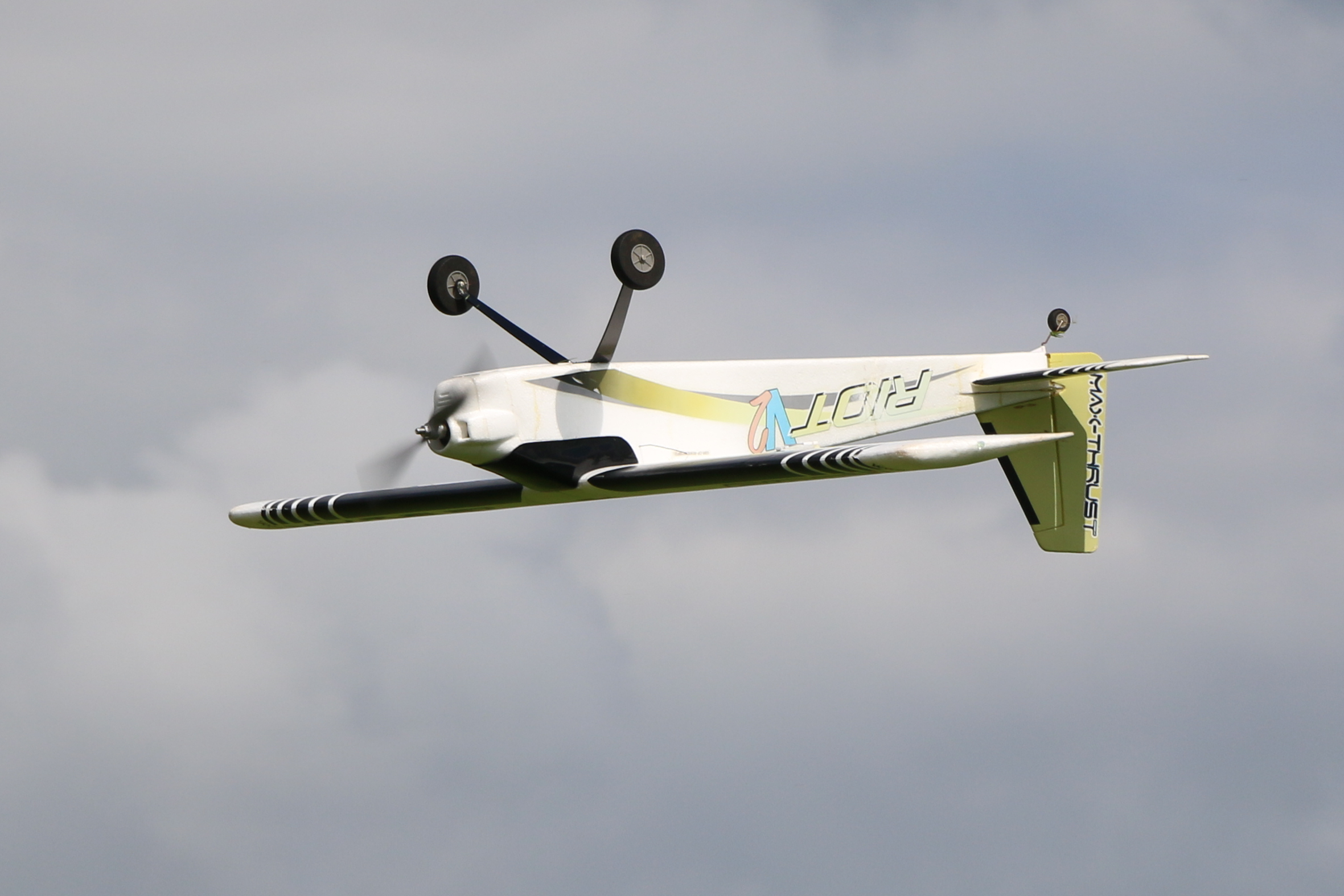
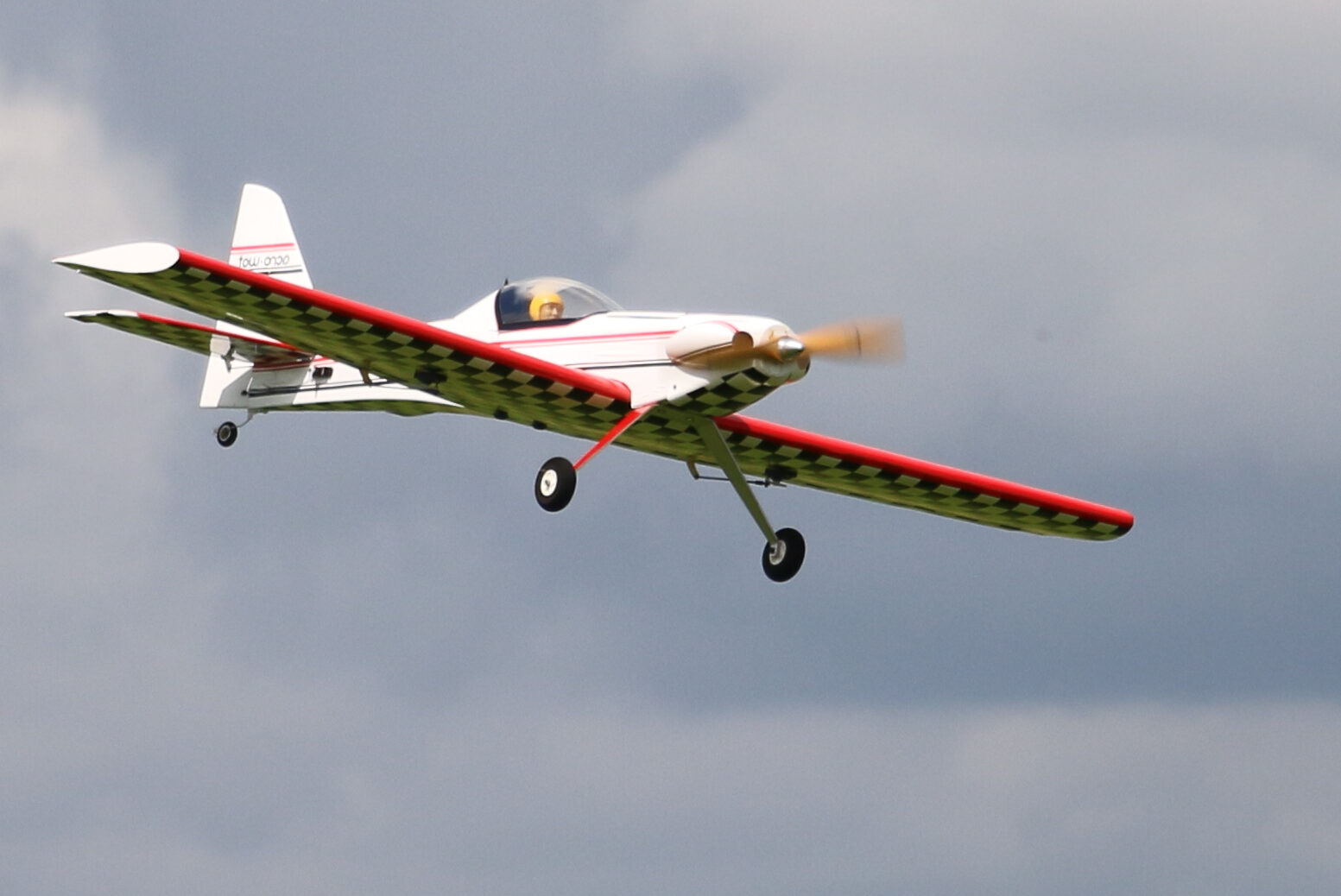

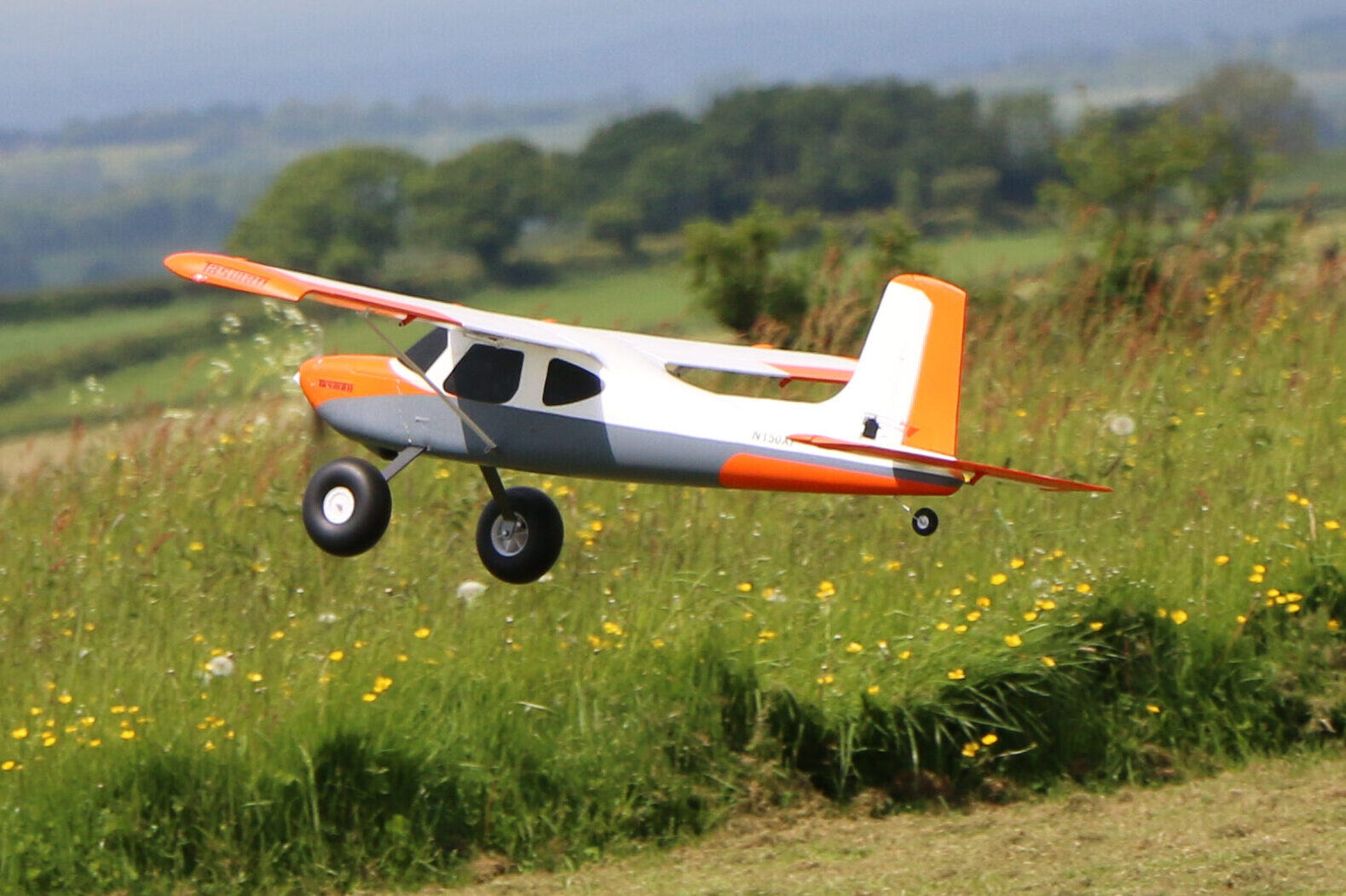
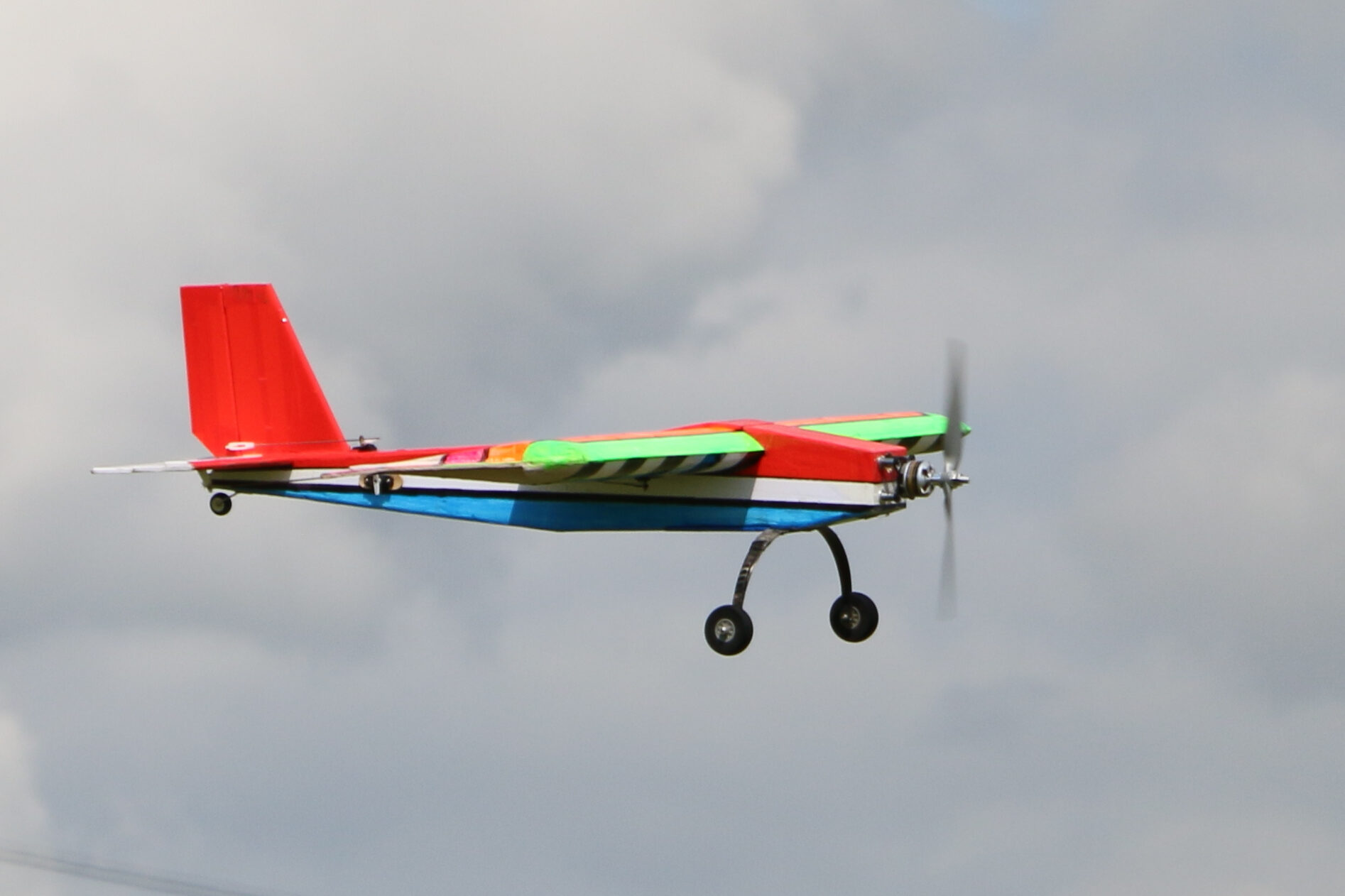
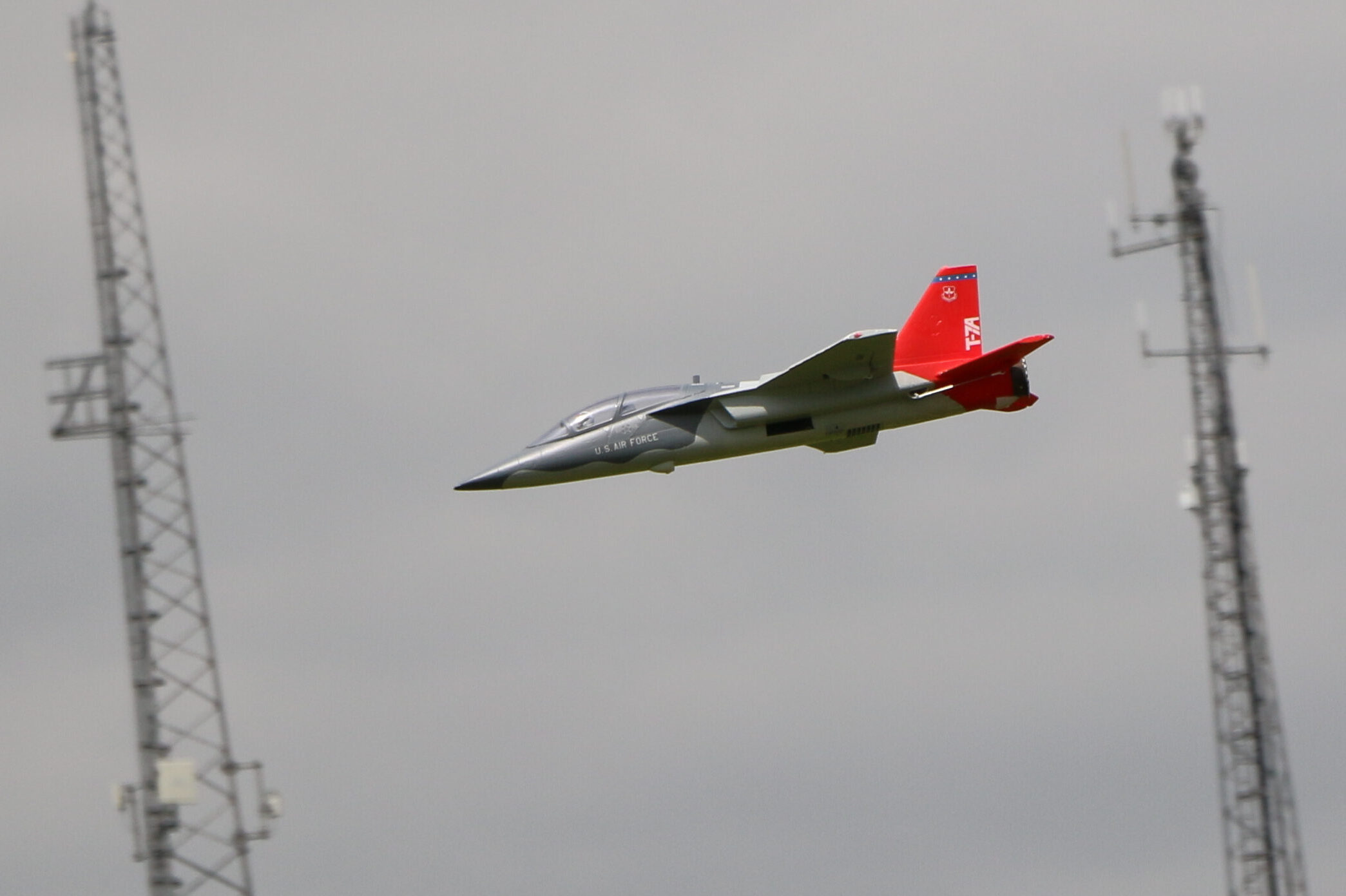
Video time now this month with footage taken by me, MacFly, and Dougal Entendre. Please watch the video full screen, it’s so much better with small models flying around:
If the video won’t play for you please click HERE
This month the end ‘joke’ is a bit sensitive so I’ve protected it with a Captcha image:
Colin Cowplain


Nice one Colin. Its hard to see what’s not there.
Nice one Colin.informative as ever.
Definitely a stealth plane can’t see
anything.
Nice one Colin, all good stuff as always.
Very enjoyable Patch News Colin.
Interesting to see the Britten Norman Islanders (was this at St Kitts?). You’ve used the wrong collective noun though – surely it should be an archipelago of Islanders rather than a gaggle?
Thanks Dougal. Yes you’re probably right about the collective noun!
But you are wrong about St Kitts, it wasn’t there.
Anybody else going to have a guess?